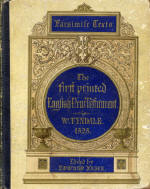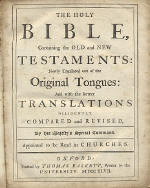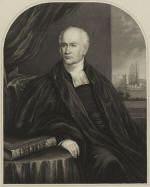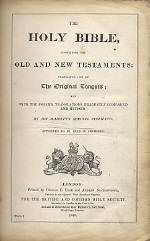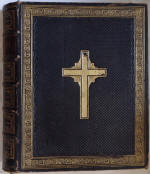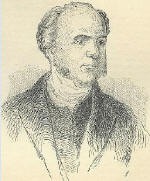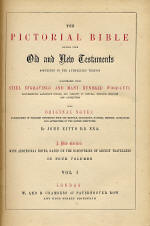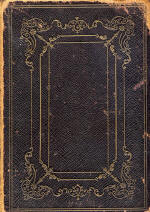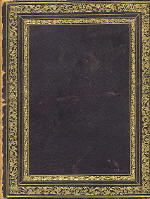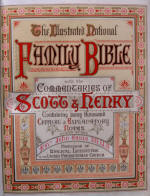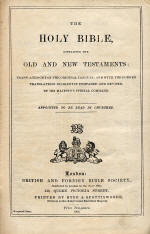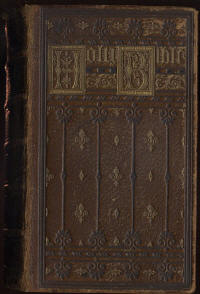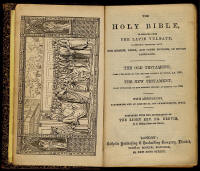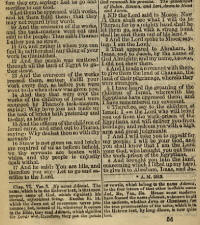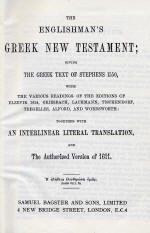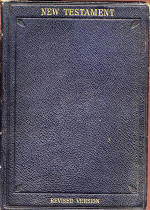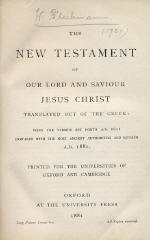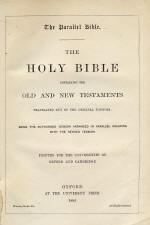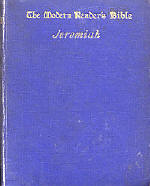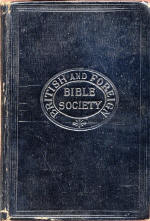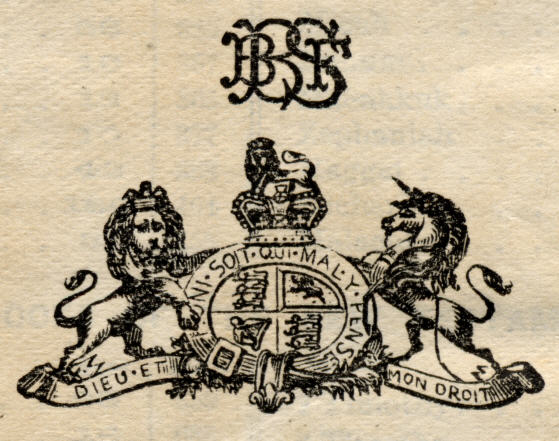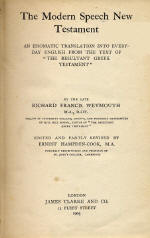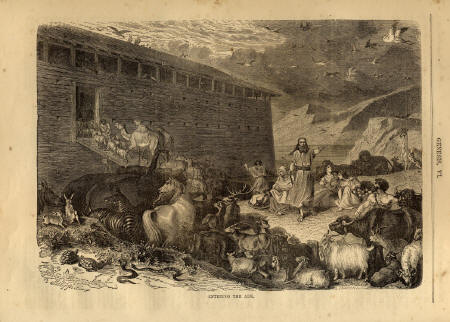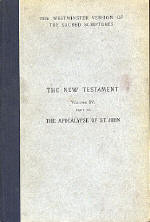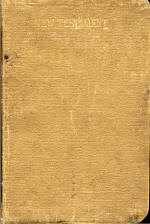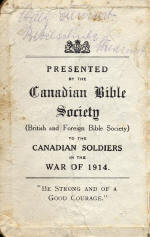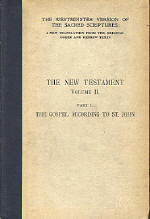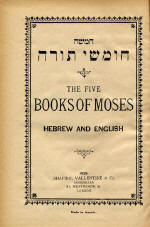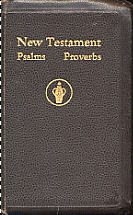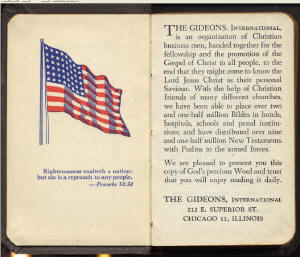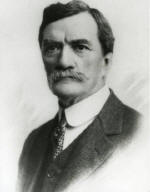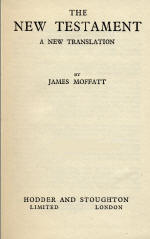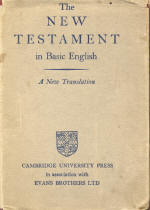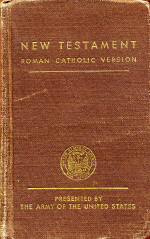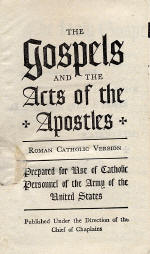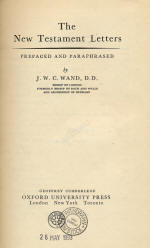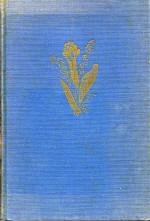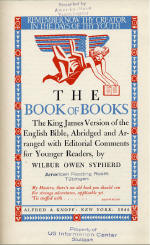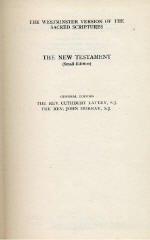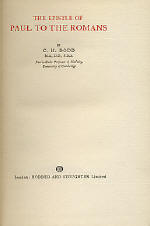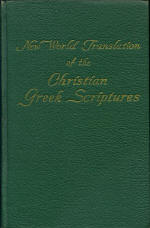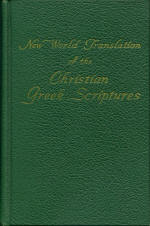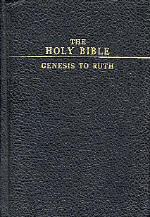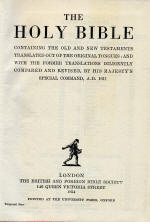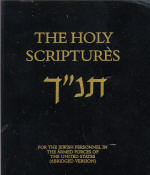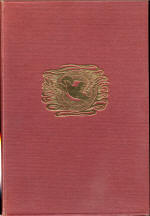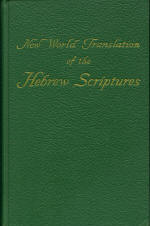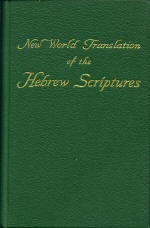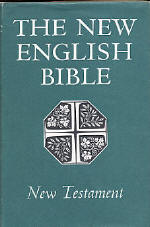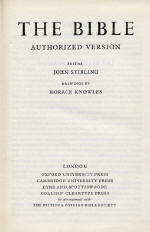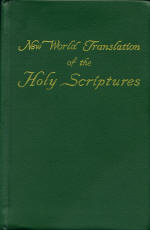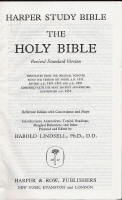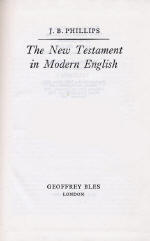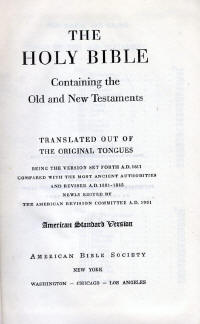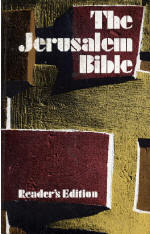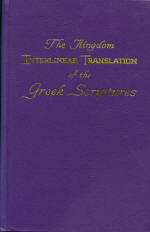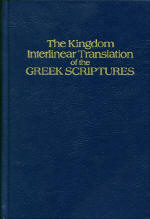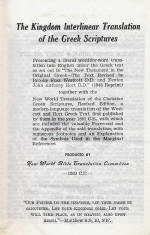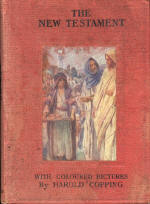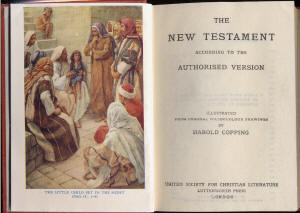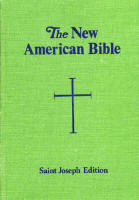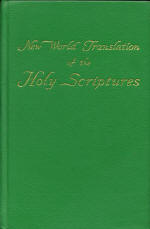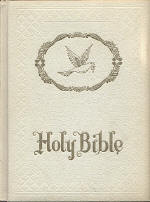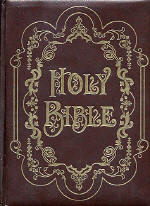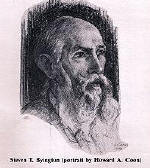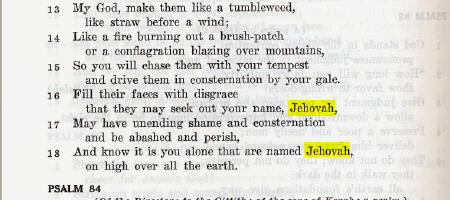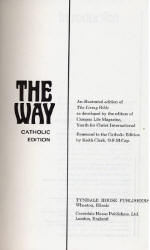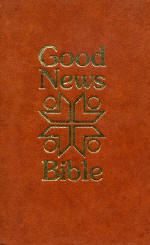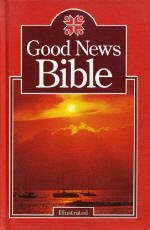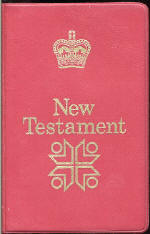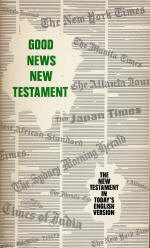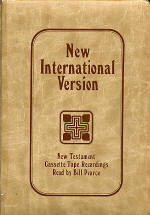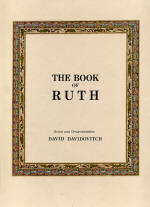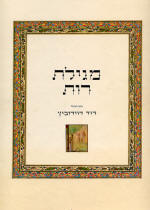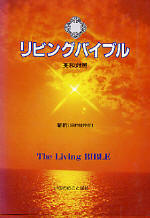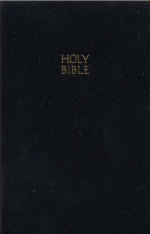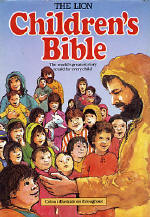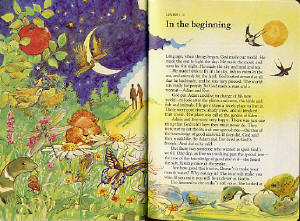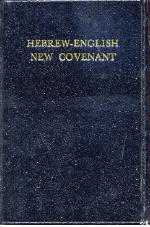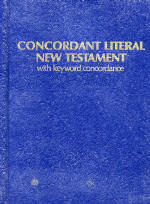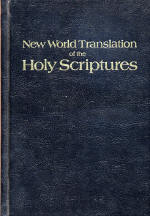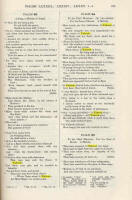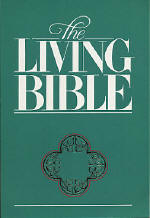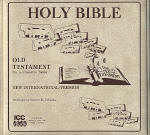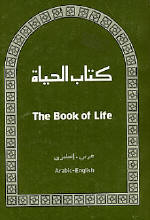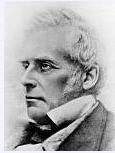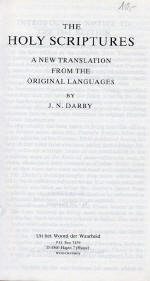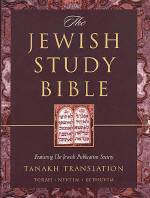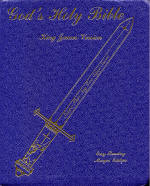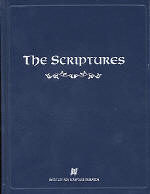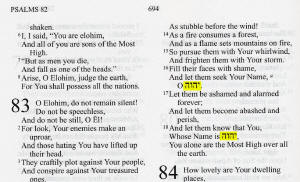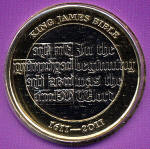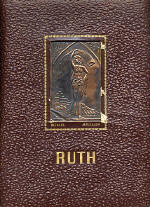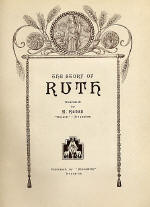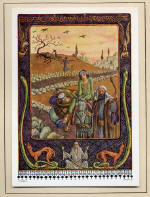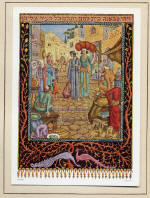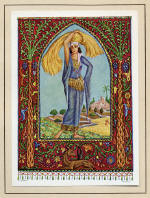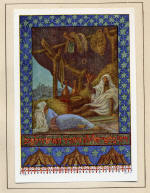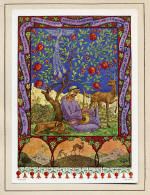Englische Bibelübersetzungen
English Bibletranslation
In chronologischer Reihenfolge
|
© Copyright by Karlo
Vegelahn E-Mail: Info@Bibelarchiv-Vegelahn.de |
Deutsche Bibeln |
||||||||||||||||||||||
|
Wissenschaftliche Ausgaben |
Fremdsprachen |
||||||||||||||||||||||
|
Bedeutung der Farben / Symbole |
|||||||||||||||||||||||
|
|
vorhandene Ausgabe |
||||||||||||||||||||||
|
Schwarz |
Bibliographische Angaben |
||||||||||||||||||||||
|
Dunkelrot |
Angaben zur Person u. Bibel |
||||||||||||||||||||||
|
Grün |
Literaturangaben |
||||||||||||||||||||||
|
Blau |
weiterführende Links |
||||||||||||||||||||||
|
Abkürzungen: WIKIPEDIA - Die freie Enzyklopädie |
Hinweis: Zum Vergrößern auf das Bild klicken.
|
||||||||||||||||||||||
|
|
|||||||||||||||||||||||
Verzeichnis:
American Standard Version 1944, 1966
Amplified BibleCassell´s Illustrated Family Bible 1910
Concordant Literal New Testament 1983
ENGLISHMAN'S GREEK NEW TESTAMENT - Authorised Version 1877
Episcopal Committee of the Cofraternity of Christian Doctrine
FIVE BOOKS OF MOSES HEBREW AND ENGLISH 1928
Good news bible : today's Engl. Version 1976, 1977, 1988
Harper Study Bible - Lindsell, Harold 1964
King James 1730, 1747, 1846, 1854, 1858, 1881, 1916, 1954, 1976, 1982
King James - Dove of Peace Edition 1971
King James - Easy ReadingKing James / Luther 1958, 1964
Kingdom Interlinear Translation of the Greek Scriptures 1969, 1985
Moulton, Richard G. 1896, 1897
NEW COVENANT IN HEBREW AND ENGLISH 1983
New English Bible 1961
New International Version 1977, 1984, 1993, 1999New Testament in Basic English 1941
Revised Standard Version 1946, 1966, 1971
The living New Testament : paraphrased 1974
The Living Bible - The way 1974, 1981, 1984, 1985
Thompson Chain Reference Edition 1992Watchtower Bible and Tract Society 1950, 1951, 1953, 1955, 1957, 1958, 1960, 1961, 1963, 1970, 1971, 1981, 1984
Westminster Version (Lattey, Cuthbert) 1915, 1927, 1929, 1931, 1947
|
1525 [1871] William Tyndale |
||
|
* 1494
|
||
|
[Biblia
: Testamentum novum <engl.>]
Facsimile
texts |
||
|
Name of God |
|
|
|
Lit.: |
Herbert, A.S.: Historical Catalogue of Printed Editions of The English Bible 1525-1961; p.1, No.1; p.421, No.1988; |
|
1730 |
||
|
|
||
|
Biblia : <engl.>
The Holy Bible,
Containing the Old and New
Testaments: Newly Translated out of the Original Tongues:
And with the former translations
Diligently Compared and Revised. Edinburg: Evan Tyler; MDCCXXXX,
MDCCXXXVIII,
|
||
|
Name of God |
|
|
|
Lit.: |
Herbert, A.S.: Historical Catalogue of Printed Editions of The English Bible 1525-1961; p.265, No.1078 |
|
1747 |
||
|
|
|
|
|
Biblia : <engl.>
The Holy Bible,
Containing the Old and New
Testaments: Newly Translated out of the Original Tongues:
And with the former translations
diligently compared and revised. Oxford: Thomas Baskett; MDCCXLVII |
||
|
Name of God |
||
|
Lit.: |
Herbert, A.S.: Historical Catalogue of Printed Editions of The English Bible 1525-1961; p.265, No.1078
|
|
1839 |
||
|
* 1778 † 1846
Biographie:
1st edition, 1814, &c.; 2nd edition, 1817; 3rd edition, 1818 |
||
|
Biblia
: <engl.> Society for Promoting Christian Knowledge.
Vol. I : Genesis -
Job
Vol. II : Psalms -
Malachi, & Apocrypha
VOL. III: Matthew - Revelation 3. Vols. – 26 cm |
||
|
Name of God |
LORD
Exodus VI,3:
3.—I appeared unto Abraham, &c.] He tells him, that He, who had formerly represented Himself to Abraham, and their forefathers, under the name of El-Shaddai, that is, the all-sufficient God, Gen. xvii. 1; and under that of Jehovah, Gen. xii. 7, 8 ; xxii. 14; would now demonstrate Himself indeed to be what the latter name imported, the unchangeable and faithful God. Pyle. I appeared to Abraham, Isaac, and Jacob, as that God, who was able and powerful to effect that which I promised : I now appear to thee as ready to make good and execute. Bp. Hall. In many places of Scripture God brings in His great name of Jehovah, as an argument of the immutability of His counsel: That which He saith, shall most certainly come to pass, because He that saith it is the Lord Jehovah. By this we see the true meaning of the passage, " By My name Jehovah was I not known to them;" that is, I never made known Myself, nor confirmed My promise to them, as I now do to thee, by saying I am Jehovah. Bp. Beveridge. When God entered into covenant with Abraham, it was by the name of "God Almighty," Gen. xvii. 1; upon which He promised to his seed the land of Canaan, ver. 8. By this name Isaac blessed Jacob, and bestowed on him the blessing of Abraham, chap. xxviii. 3, 4. By this name again Jacob blessed Joseph, chap. xlviii. 3; xlix. 25. God lets them here know, that He, who had made a promise to their fathers by the name .of " God Almighty," would now confirm His covenant to them, and make His promise good by the name of " Jehovah." For this name denotes, not only God's eternal being, but His giving of being to other things, and especially the performing of His promise. Abraham, Isaac, and Jacob had received promises, but enjoyed not the thing promised. The time was now come, in which God would bring to pass what He had promised; and now they should 1cnow that He is THE LORD. Bp. Kidder. It means that God having actually given defence and plenty to Abraham, Isaac, and Jacob, was already known to them by the names of " El," Almighty,- and " Shaddai," All-sufficient : but that having not fulfilled to them His promise of giving to them or their seed the land of Canaan, He was not yet known to them by His name JEHOVAH, which imports a God, constant to Hist: word, and " the same yesterday, and to-day, and for ever," Heb. xiii. 8. Abp. Tenison. |
|
|
Lit.: |
Herbert, A.S.: Historical Catalogue of Printed Editions of The English Bible 1525-1961; p.356, No.1658 |
|
1846 |
||
|
|
|
|
|
Biblia
: <engl.>
translated out of the Original Tongues; and with the former translations
diligently compared and revised. |
||
|
Name of God |
Lord, |
|
1850 ca |
||
|
|
||
|
Biblia
: <engl.>
Vol.II, London: / George Henry and Co., 64, Bartholomew Close.
p.
385, X, 355 - 44 cm |
||
|
Name of God |
Lord |
|
1850 ? |
||
|
John Kitto
* 1804 † 1854
|
||
|
|
Biblia
: <engl.>
According to the
Authorised version. ... By John Kitto D.D. f.S.A. A New
Edition. ... in four Volumes |
|
|
|
THE Authorised Version of the SACRED SCKIPTOEES, translated from the Original tongues, and first printed in 1611, by order of JAMES I., has, as is well known, been frequently issued with doctnnal and other expositions, according to the views of different denominations of Christians. The present work, comprising the entire Authorised Version of the BIBLE, was issued some years ago on a plan more generally acceptable than had hitherto been attempted. Abstaining in a great measure from such doctrinal exposition as was already provided for in the Commentaries of HENRY, CLAKKE, SCOTT, and others, it aimed at laying before the general as well as the scholar, an Annotated Edition of the BiBLE-designed for no particular denomination, but for ALL. The Notes, copiously interspersed, were fumisned by the late lamented Dr JOHN KIITO; and besides illustrating the History Geography, Zoology, Botany, Ethnography, and miscellaneous subjects of interest referred to in HOLY WRIT, presented such critical remarks as tended to develop the meaning of the SACRED WRITERS. Illustration through the agency of Pictonal Art was at the same time afforded in a style which may safely be-said to have had no precedent, for besides the mere fancy designs of the Ancient Masters, there were here veritable representations of an immense variety of objects. Scenic or Local, Histoncal or Antiquarian, and connected with Zoology and Botany, such as had but httle attention in previous editions of the BIBLE. Wiith these recommendations, it may be said that no Annotated or Illustrated Edition of the SACRED SCRIPTURES ever attained such universal popularity-ever was so acceptable to the hearts and the homes of the People of this Country. The copyright and stereotype plates of the work having passed into the hands of the present Publishers, it became with them a matter of consideration how they might best sustain its high character. The course they ultimately determmed on, was governed in some measure by the fact of the decayed health of the onginal Editor. They deemed it best to leave his Notes in their integrity, and merely to add, in an Appendix to each volume, such others as were called for in consequence of the researches of LAYARD, LEPSIUIS, and other travellers and investigators in the Lands of the BIBLE.
They at the same time gave such directions
as have insured a high degree of excellence i the Typography - the
impressions of the Wood-engravings, in particular, being executed with a
delicacy which may well challenge a preference for this Edition over any
that have gone before it.
|
|
|
Name of God |
Lord,
|
|
1854 |
||
|
|
||
|
Biblia : <engl.>
The Holy Bible :
containing the Old and New
Testaments, translated out of the original tongues,
and with the former translations
diligently compared and revised.
|
||
|
Name of God |
|
|
|
Lit.: |
|
|
1857 |
||
|
|
Henry, Matthew (Pfarrer) *1662-1714* |
|
|
Biblia : <engl.> An exposition
of the Old and New Testament:
wherein each chapter is summed up in its contents; the sacred text
inserted at large in distinct paragraphs; each paragraph reduced to its
proper heads; the sense given, and largely illustrated : with practical
remarks and observations / by Matthew Henry. with a few prefatory remarks
by the rev. Edward Bickersteth |
||
|
Name of God |
LORD, |
|
|
Lit.: |
|
|
1858 |
||
|
|
|
|
|
Biblia : <engl.> Eadie, John (editor) The
National Comprehensive
Family Bible
- The Holy Bible with the Commentaries
of Scott and Henry and containing also many thousand critical and
explanatory notes selected from the great standard authors
33 cm |
||
|
Name of God |
|
|
|
Lit.: |
|
|
1858 - King James |
||
|
|
|
|
|
Biblia : <engl.> o. S. – 18 cm |
||
|
Name of God |
|
|
|
Lit.: |
|
|
1874 - Douay |
||
|
|
|
|
|
|
Biblia : <engl.> |
|
|
|
Exodus Chap.VI:
|
|
|
Name of God |
|
|
1877 |
||
|
|
siehe auch unter Griechische Bibeln |
|
|
Biblia : <engl.>
|
||
|
Name of God |
|
|
1881 |
||
|
|
|
|
|
|
Biblia
: <engl.> Oxford: University Press p. XXII, 496 – 18 cm |
|
|
Name of God |
|
|
|
Lit.: |
Herbert, A.S.: Historical Catalogue of Printed Editions of The English Bible 1525-1961; p.427, No.2017 |
|
1885 |
||
|
|
|
|
|
The Parallel
Bible |
||
|
|
ADVERTISEMENT. In this Volume are printed, in parallel columns, the Authorised Version of 1611 and the Revised Version, of which last the Old Testament appeared in 1885 and the New Testament in 1881. The left hand column contains the text of the Authorised Version as usually printed, with the marginal notes and references of the edition of 1611, the spelling of these being conformed to modern usage. In the left hand margin are also placed, in square brackets, the more important differences between the edition of 1611 and the text now in use, whether these differences are due to corrections of the edition of 1611 or to errors which have subsequently crept in. The right hand column contains the Revised Version, with its marginal notes and references. The Prefaces of the Eevisers, and the lists of renderings preferred by the American Committee, are also included in this Volume. |
|
|
Lit.: |
Herbert, A.S.: Historical Catalogue of Printed Editions of The English Bible 1525-1961; p.432, No.2040 |
|
1896- |
||
|
|
|
|
|
|
Biblia
: <engl.> p. XXXVII, 202 – 15 cm
Jeremiah; edited, with an
introduction and notes, by Richard
G. Moulton ..., p. XIV, 237 – 15 cm |
|
|
Name of God |
|
|
|
Lit.: |
Herbert, A.S.: Historical Catalogue of Printed Editions of The English Bible 1525-1961; p.454, No.2142 |
|
1902 |
||
|
|
|
|
|
Biblia
: <engl.> p. XIV,
513 – 195 cm |
||
|
Name of God |
Lord |
|
|
Lit.: |
Herbert, A.S.: Historical Catalogue of Printed Editions of The English Bible 1525-1961; p.547 No.2113 |
|
1906 - King James |
||
|
|
|
|
|
Biblia : <engl.> 862 S.
– 18 cm
|
||
|
Name of God |
|
|
|
Lit.: |
|
|
1903 - Weymouth |
||
|
|
* 26.10.1822 near Plymouth, Devon, Eng. † 27.12.1902 Bentwood, Essex
siehe:
|
|
|
Biblia
: <engl.> London : J.
Clarke, 1909 |
||
|
Name of God |
|
|
|
Lit.: |
Herbert, A.S.: Historical Catalogue of Printed Editions of The English Bible 1525-1961; p.452, No.2132 |
|
1910 ca. |
||
|
|
|
|
|
Biblia
: <engl.> London, Paris & Melbourne: Cassell and Company, Limited
p. XXI, 1264, XIII, 424 33 cm
|
||
|
Name of God |
|
|
|
Lit.: |
|
|
1915 |
||
|
Testamentum
novum <engl.>
The New
Testament - Volume IV
p. XXIV, 54 – 19 cm
|
||
|
Name of God |
|
|
|
Lit.: |
Herbert, A.S.: Historical Catalogue of Printed Editions of The English Bible 1525-1961; p.474, No.2251 |
|
1916 |
||
|
|
|
|
|
The New Testament of Our Lord and Saviour Jesus Christ, transl. out of the Greek : Being the version set forth A.D.1611 London: British and Foreign Bible Society Printed at the University Press, Oxford p. 384
PRESENTED BY THE Canadian Bible Society (British and Foreign Bible
Society) TO THE CANADIAN SOLDIERS IN THE WAR OF 1914. |
||
|
Name of God |
|
|
|
Lit.: |
|
|
1927 |
||
|
|
Testamentum
novum <engl.>
The New
Testament - Volume II
p. XXXIX, 117 – 19 cm
The New
Testament - Volume III
p. LXIII, 258 – 19 cm
The New
Testament - Volume IV
p. LX, 220 – 19 cm |
|
|
|
Name of God |
|
|
Lit.: |
Herbert, A.S.: Historical Catalogue of Printed Editions of The English Bible 1525-1961; p.474, No.2251 |
|
|
|
|
|
|
Biblia
: <hebr. engl.>
p. 350, 350
|
||
|
Name of God |
Lord Ex 3, 15: The Everlasting One Ex 6, 3: The Etenal |
|
|
Lit.: |
|
|
|
|
|
|
|
|
National - Edition mit Psalmen 12 x7 cm |
|
|
Name of God |
LORD, Ps. 83, 18: JEHOVAH |
|
|
Lit.: |
|
|
|
|
|
|
|
|
National - Edition
conformable to the edition 1611 Commonly known as the Authorized or King
James Version 12 x7 cm
|
|
|
Name of God |
LORD, Ps. 83, 18: JEHOVAH |
|
|
Lit.: |
|
|
1941 - James Moffatt |
||
|
* 04.07.1870 Glasgow † 27.06.1944 New York
|
||
|
|
Testamentum
novum <engl.> |
|
|
|
In his essay on Protestantism, de Quincey has a characteristic paragraph upon the popular delusion that "every idea and word which exists, or has existed, for any nation, ancient or modern, must have a direct interchangeable equivalent in all other languages." No one who attempts to translate any part of the New Testament is likely to remain very long under such a delusion. Thus there is no exact English equivalent for terms like λογος and μυστηριον and δικαιοσυνη. The first of these I have simply transliterated once or twice; "Logos" is at any rate less misleading than "Word" would be to a modern reader. Even when an equivalent can be got for some New Testament term like εθνη or Αιδης, it cannot be used invariably. I have kept " Gentiles " for εθνη in cases where the contrast between Judaism and the outer world is prominent; if Kipling's "Recessional" was intelligible to modern readers, "Gentiles" here should not cause them undue difficulty. But now and then the Greek term carries a sense which can only be represented by our "pagans" or "heathen," and occasionally it is no more than "nations." This will serve as an illustration of the difficulties which confront a translator. But once the translation of the New Testament is freed from the influence of the theory of verbal inspiration, these difficulties cease to be so formidable. I have tried not to sacrifice the spirit to the letter. It is true, as de Quincey observes in the same essay, that "the great ideas of the Bible protect themselves. The heavenly truths, by their own imperishableness, defeat the mortality of languages with which for a moment they are associated." Still, this is a victory in which even the camp-followers or translators have a modest share. They can or they should further this linguistic triumph. Hellenistic Greek has its own defects, from the point of view of the classical scholar, but it is an eminently translatable language, and the evidence of papyrology shows it was more flexible than once was imagined. My intention, therefore, has been to produce a version which will to some degree represent the gains of recent lexical research and also prove readable. I have attempted to translate the New Testament exactly as one would render any piece of contemporary Hellenistic prose; in this way, students of the original text may perhaps be benefited. But I hope also that the translation may fall into the hands of some who know how to freshen their religious interest in the meaning of the New Testament by reading it occasionally in some unauthorized English or foreign version, as well as into the hands of others who for various reasons neglect the Bible even as an English classic. This is a hope which, no doubt, is accompanied with some risks and fears. Every translation has to face a double ordeal. Some of its readers know the original, some do not, and both classes have to be met. "The English reader," as Dr. Rouse remarks, "may be quite competent to judge of a translation as literature and as intelligible or not intelligible, but he cannot judge of its accuracy. The scholar alone can judge of its accuracy, but (granting that he has literary taste) he knows the original too well to be independent of it, and hence cannot judge of the impression which the translation will make on the minds of those who are not scholars." If this is true of Homer, it is three times true of the New Testament. Any new translation starts under a special handicap. It appears to challenge in every line the rhythm and diction of an English classic, and this irritates many who have no knowledge of the original. The old, they say, is better. They are indifferent to the changes which recent grammatical research has necessitated in the translation of the aorist, the article, and the particles, for example, even since the Revised Version of 1881 was made. But intelligibility is more than associations, and to atone in part for the loss of associations I have endeavoured to make the New Testament, especially St. Paul's epistles, as intelligible to a modern English reader as any version that is not a paraphrase can hope to make them.This raises one of the numerous points of difficulty that beset the translator. How far is he justified in modernizing an Oriental book? How far can he assume that certain turns of expression have become naturalized in English by the Authorized Version itself? I have never seen any satisfactory solution of this problem, and I have not been able to find one. However, it is superfluous to discuss such matters at length. This is not the place to develop any theories on the subject. What the general public cares for is a translator's practice rather than his principles, and students can easily detect the latter, or the lack of them, in the former.I wish only to add this caution, that a translator appears to be more dogmatic than he really is. He must come down on one side of the fence or on the other. He has often to decide on a rendering, or even on the text of a passage, when his own mind is by no means clear and certain. In a number of cases, therefore, when the evidence is conflicting, I must ask scholars and students to believe that a line has been taken only after long thought and only with serious hesitation. The translation has been made from the text recently issued by Von Soden of Berlin, but I have not invariably followed his arrangement and punctuation. Wherever I have felt obliged to adopt a different reading, this is noted at the foot of the page. Quotations or direct reminiscences of the Old Testament are printed in italics. The books are arranged for the convenience of the general reader in the order of the English Bible. This applies to the order of chapters as well. Thus the last four chapters of Second Corinthians appear in their usual canonical position instead of in what I believe to be their original position between First and Second Corinthians. The only exception I have made to this rule is in the case of some occasional transpositions either of verses or of paragraphs, for example, in the case of the Fourth Gospel. Any one who cares to look into the evidence for such changes will find it in myIntroduction to the Literature of the New Testament. Lastly, it is right to add that I have not consulted any other version of the New Testament in preparing this work, though probably echoes and reminiscences have clung to one's mind. The only version I have kept before me is the one I prepared thirteen years ago for my Historical New Testament. But the present version is not a revision of that. It is an independent work. I agreed to undertake it with sharp misgivings, but I trust that the spirit and method of its composition may at any rate do something to make some parts of the New Testament more intelligible to some readers.
JAMES MOFFATT.
|
|
|
Lit.: |
|
|
1941 |
||
|
|
||
|
Testamentum
novum <engl.> |
||
|
|
NOTE Working with the Orthological Institute, a Committee under the direction of Prof. S. H. Hooke, Samuel Davidson Professor in the University of London, has been responsible for a new English form of the Bible based on the Hebrew and the Greek. In this undertaking, the latest ideas and discoveries in connection with the work of putting the Bible into other languages were taken into account, and when the Basic form was complete it was gone over in detail by a Committee formed by the Syndics of the Cambridge University Press. The Basic New Testament, which in this way was watched over by two separate groups of experts through its different stages, is designed to be used wherever the English language has taken root. Frequently, the narrow limits of the word-list make it hard to keep the Basic completely parallel with the Greek; but great trouble has been taken with every verse and every line to make certain that there are no errors of sense and no loose wording. It is only natural that, from time to time, some of the more delicate shades of sense have not been covered; on the other hand, it is well to keep in mind that in the Authorised Version the power and music of the language sometimes take so much of the reader's attention that these more delicate shades are overlooked.
In fact, the Basic expert is
forced, because of the limited material with which he is working, to give
special care to the sense of the words before him. There is no question of
the Basic work taking the place of the Authorised Version or of coming
into competition with it; but it may be said of this new English Bible
that it is in a marked degree straightforward and simple and that these
qualities give it an independent value. |
|
|
Lit.: |
Herbert, A.S.: Historical Catalogue of Printed Editions of The English Bible 1525-1961; p.479, No.2277 |
|
1941 |
||
|
|
|
|
|
Biblia
: <engl.>
|
||
|
Name of God |
Lord |
|
|
Lit.: |
|
|
1941 |
||
|
|
|
|
|
Biblia
: <engl.>
|
||
|
Name of God |
Jehovah |
|
|
Lit.: |
Herbert, A.S.: Historical Catalogue of Printed Editions of The English Bible 1525-1961; p.481 |
|
1944 |
||
|
|
|
|
|
Biblia
: <engl.>
|
||
|
Name of God |
||
|
Lit.: |
Herbert, A.S.: Historical Catalogue of Printed Editions of The English Bible 1525-1961; p.473, No.2248 |
|
1944 |
||
|
|
|
|
|
Biblia
: <engl.>
Printed and Distributed by Watchtower Bible and
Tract Society
Biblia
: <engl.> |
||
|
Name of God |
Je-ho´vah
|
|
|
Lit.: |
Herbert, A.S.: Historical Catalogue of Printed Editions of The English Bible 1525-1961; p. |
|
1946 |
||
|
|
|
|
|
Testamentum
novum <engl.> |
||
|
PREFACE |
The Revised Standard Version of the New
Testament is an authorized revision of the
American Standard Version, published in 1901, which was a revision of the
King The American Standard Version was copyrighted to protect the text from unauthorized changes; and in 1928 Thomas Nelson and Sons, its publishers, transferred the copyright to the International Council of Religious Education, in which the educational boards of forty of the major Protestant denominations of the United States and Canada are associated. This body appointed a committee of scholars to have charge of the text, and authorized it to undertake further revision if deemed necessary. The charter of the Committee contains the provision that "all changes in the text shall be agreed upon by a two-thirds vote of the total membership of the Committee"—a more conservative rule than that which had governed revision hitherto, which required only a twothirds vote of members present. In 1937 a comprehensive revision of the American Standard Version of the Bible was authorized by vote of the Council. Conversations with British scholars looked toward corre spondence with a similar committee to be organized in Great Britain; but this proved to be impracticable during the years of war. The Committee has worked in two Sections, one dealing with the Old Testament and one with the New Testament. As with former revisions, the work upon the New Testament has been completed first; and the revision of the Old Testament will take about four years more. All changes in the translation of the New Testament have been submitted to the entire Committee, and in a few cases a majority vote in the Section has been reversed by failure to receive the support of two-thirds of the members of the Committee. This preface does not undertake to set forth the lines along which the revision has proceeded. That is done in a small book entitled An Introduction to the Revised Standard Version of the New Testament, written by the members of the New Testament Section, and designed to help the general public to understand the main principles which have guided this com prehensive revision of the King James and American Standard Versions. Let it be said here simply that all of the reasons which led to the demand for revision of the King James Version one hundred years ago are still valid, and are even more cogent now than then. And we cannot be content with the Versions of 1881 and 1901 for two main reasons. One is that these are mechanically exact, literal, word-for-word translations, which follow the order of the Greek words, so far as this is possible, rather than the order which is natural to English; they are more accurate than the King James Version, but have lost some of its beauty and power as English literature. The second reason is that the discovery of a few more ancient manuscripts of the New Testament and of a great body of Greek papyri dealing with the everyday affairs of life in the early centuries of the Christian era, has furnished scholars with new resources, both for seeking to recover the original text of the Greek New Testament and for understanding its language. In the Bible we have not merely an historical document and a classic of English literature, but the Word of God. The Bible carries its full message, not to those who regard it simply as a heritage of the past or praise its literary style, but to those who read it that they may discern and understand God's Word to men. And men need the Word of God in our time and hereafter as never before. That Word must not be disguised in phrases that are no longer clear, or hidden under words that have changed or lost their meaning. It must stand forth in language that is direct and plain and meaningful to people today. It is our hope and our earnest prayer that this Revised Standard Version of the New Testament may be used by God to speak to men in these momentous times, and to help them to understand and believe and obey His Word. |
|
|
Lit.: |
Herbert, A.S.: Historical Catalogue of Printed Editions of The English Bible 1525-1961; p.473, No.2248 |
|
1947 |
||
|
|
|
|
|
|
Testamentum
novum <engl.> |
|
|
Name of God |
|
|
|
Lit.: |
Herbert, A.S.: Historical Catalogue of Printed Editions of The English Bible 1525-1961; p.474, No.2251 |
|
1949 |
||
|
|
|
|
|
The Epistle of Paul to the
Romans / by C.
H. Dodd. - 12. impr.
|
||
|
Name of God |
|
|
|
Lit.: |
|
|
1950 |
||
|
|
||
|
Biblia
: <engl.> |
||
|
Name of God |
|
|
|
Lit.: |
Herbert, A.S.: Historical Catalogue of Printed Editions of The English Bible 1525-1961; p.483, No.2299, p.490, No.2329 |
|
1951 |
||
|
|
||
|
Biblia
: <engl.> |
||
|
Name of God |
|
|
|
Lit.: |
|
|
|
|
||
|
|
Biblia
: <engl.> |
|
|
Foreword |
PREFACE "Inspired by the Divine Spirit, the Sacred Writers composed these books which God, in His paternal charity toward the human race, deigned to bestow on them 'for teaching, for reproving, for correcting, for instructing in justice; that the man of God may beperfect, equipped for every good work' (2 Tm 3, 16f). This heaven-sent treasure Holy Church considers as the most precious source of doctrine on faith and morals. No wonder therefore that, as she received it intact from the hands of the Apostles, she has kept it with all care, defended it from every false and perverse interpretation, and used it diligently as an instrument for securing the eternal salvation of souls" (Pope Pius XII, encyclical letter Divino afflante Sptritu, September 30, 1943). In conformity with the spirit of this encyclical of Pope Pius XII, and with the encouragement of His Excellency the Apostolic Delegate to the United States, the Episcopal Committee of the Confraternity of Christian Doctrine requested members of the Catholic Biblical Association of America to translate the Sacred Scriptures from the original languages or from the oldest extant form of the text, and to present the sense of the Biblical text in as correct a form as possible. The first printed English Catholic version of the Bible, the Douay-Rheims version, and its revision by Bishop Challoner were based on the Latin Vulgate.- Today, however, when the science of textual criticism has attained great perfection, it is desirable that a new English version of the Sacred Books be prepared, combining due reverence for the text with strict observance of the rules of criticism. The use of the original texts as the basis of a new translation does not derogate from the decree of the Council of Trent concerning the Latin Vulgate. The Council does not forbid "translations into the vernacular tongue even directly from the original texts themselves, for the use and benefit of the faithful and for the better understanding of the divine word, as We know to have been already done in a laudable manner in many countries with the approval of the Ecclesiastical authority" (Divino afflante Spiritu). The text of the eight books (Genesis to Ruth) contained in this volume is but the first part of a completely new translation of the Bible. This translation is based on the original and oldest texts of the Sacred Books. It gives the translators opportunity to convey directly the thought and individual style of the inspired writers. A better understanding of Hebrew and of the science of textual criticism, which has been the fruit of earnest and patient study since the time of St. Jerome, can now be reflected in the translation itself. The translators and editors intend to draw constantly on all material available to obtain in every instance a translation which represents, as far as possible, what the Sacred Author actually wrote. In most matters pertaining to format and manner of presentation this new translation will follow the pattern set by the Confraternity revision of the New Testament. In only one respect do circumstances require an addition. Where the translation supposes the received text (Hebrew, Aramaic or Greek, as the case may be), which is ordinarily contained in the best-known editions, as the original or the oldest extant form, no additional remarks are necessary. But for the benefit of those who are happily able to study the original text of the Scriptures at first hand, a supplementary series of Textual Notes has been added in an appendix. These furnish a guide in all cases in which the editorial board has judged that either manuscripts in the original language, or the evidence of the ancient versions, or some similar source, furnish the correc reading of a passage, or at least a form more true to the original than that customarily printed in the available editions. As regards the matter of English style, it will be seen that the deliberate compromise with earlier usage frequently retained in Bible translations has here been given up. The work of translating the Bible has been characterized as "the sacred and apostolic work of interpreting the word of God and of presenting it to the laity in translations as clear as the difficulty of the matter and the limitations of human knowledge Permit" (His Excellency A. G. Cicognani, Apostolic Delegate, in the Catholic Biblical Quarterly, 6, 1944, 389f). In the appraise ing of the present work, it is hoped that the words of the encyclical Divino afflante Spiritu will serve as a guide: "Let all the sons of the Church bear in mind that the efforts of these resolute laborers in the vineyard of the Lord should be judged not only with equity and justice, but also with the greatest charity; all moreover should abhor that intemperate zeal which imagines that whatever is new should for that very reason be opposed or suspected." Conscious of their personal limitations for the task thus defined those who have prepared this text cannot hope that it will be perfect, but only that it may deepen in its readers the right understanding of the divinely given Scriptures," and awaken in them "that piety by which it behooves us to be grateful to the God of all providence, who from the throne of His majesty has sent these books as so many personal letters to His own children (Divino afflante Spiritu). |
|
|
Name of God |
LORD, siehe auch Exodus 3,14 f.:
14 Then he added, "This is what you shall tell the Israelites: I Am sent me to you."
15 God spoke further to Moses, "Thus shall you say to the Israelites: The LORD, the God of your fathers, the God of Abraham, the God of Isaac, the God of Jacob, has sent me to you. "This is my name forever; this is my titel for all generations.
3, 14: I am who am: apparently this utterance is the source of the word Yahweh, the proper personal name of the God of Israel. It is commonly explained in reference to God as the absolute and necessary Being. It may be understood of God as the Source of all created beings. Out of reverence for this name, the term Adonai, "my Lord," was later used as a substitute. The word LORD in the present version represents this traditional usage. The word "Jehovah" arose from a false reading of this name as it is written in the current Hebrew text. |
|
|
Lit.: |
|
|
1953 |
||
|
|
||
|
Biblia
: <engl.> |
||
|
Name of God |
|
|
|
Lit.: |
Herbert, A.S.: Historical Catalogue of Printed Editions of The English Bible 1525-1961; p.490, No.2329 |
|
1954 |
||
|
|
|
|
|
Biblia : <engl.>
|
||
|
Name of God |
|
|
|
Lit.: |
|
|
1955 |
||
|
|
||
|
Biblia
: <engl.> |
||
|
Name of God |
|
|
|
Lit.: |
Herbert, A.S.: Historical Catalogue of Printed Editions of The English Bible 1525-1961; p.490, No.2329 |
|
1955 |
||
|
|
|
|
|
|
Biblia
: <engl.>
for the Jewish Personnel in the armed forces of the United
States (Abridged Version |
|
|
Vorwort |
Preface The following is from the preface to the Jewish Publication Society's 1917 edition of the Hebrew Bible in English: The sacred task of translating the Word of God, as revealed to Israel through lawgiver, prophet, psalmist, and sage, began at an early date. According to an ancient rabbinic interpretation, Joshua had the Torah engraved upon the stones of the altar (Joshua 8:32) not in the original Hebrew alone, but in all the languages of mankind, which were held to be seventy, in order that all men might become acquainted with the words of the Scriptures. This statement, with its universalistic tendency, is, of course, a reflex of later times, when the Hebrew Scriptures had become a subject of curiosity and perhaps also of anxiety to the pagan or semi-pagan world. While this tradition contains an element of truth, it is certain that the primary object of translating the Bible was to minister to a need nearer home. Upon the establishment of the Second Commonwealth under Ezra and Nehemiah, it became imperative to make the Torah of God 'distinct and giving sense' through the means of interpretation (Nehemiah 8:8 and 13:24), that the Word of God might be understood by all the people. The Rabbis perceived in this activity of the first generation of the Sopherim the origin of the Aramaic translation known as the Targum, first made orally and afterwards committed to writing, which was necessitated by the fact that Israel had forgotten the sacred language, and spoke the idiom current in a large part of western Asia. All this, however, is veiled in obscurity, as is the whole inner history of the Jews during the Persian rule. The historic necessity for translation was repeated with all the great changes in Israel's career. It is enough to point to the Septuagint, or the Greek translation of the Scriptures, the product of Israel's contact with the Hellenistic civilization dominating the world at that time; to the Arabic translation by the Gaon Saadya, when the great majority of the Jewish people came under the sceptre of Mohammedan rulers; and to the German translation by Mendelssohn and his school, at the dawn of a new epoch, which brought the Jews in Europe, most of whom spoke a German dialect, into closer contact with their neighbours. These translations are all historical products intimately connected with Israel's wanderings among the nations and with the great events of mankind in general. Ancient and continuous as this task of translation was, it would be a mistake to think that there were no misgivings about it. At least it is certain that opinions were divided as to the desirability of such undertakings. While Philo and his Alexandrian coreligionists looked upon the translation of the Seventy as a work of inspired men, the Palestinian Rabbis subsequently considered the day on which the Septuagint was completed as one of the most unfortunate in Israel's history, seeing that the Torah could never be adequately translated. And there are indications enough that the consequences of such translations were not all of a desirable nature. However, in view of the eagerness with which they were undertaken almost in every land and in every great epoch of the world's history, it is evident that the people at large approved of such translations, thinking them to be a heave-offering to the Lord of each newly acquired vernacular adopted in the course of the ever-changing conditions of history, and in particular a tribute to the beauty of Japheth dwelling in the spiritual tents of Israel. The greatest change in the life of Israel during the last two generations was his renewed acquaintance with English-speaking civilization. Out of a handful of immigrants from Central Europe and the East who saw the shores of the New World, or even of England and her colonies, we have grown under Providence both in numbers and in importance, so that we constitute now the greatest section of Israel living in a single country outside of Russia. We are only following in the footsteps of our great predecessors when, with the growth of our numbers, we have applied ourselves to the sacred task of preparing a new translation of the Bible into the English language, which, unless all signs fail, is to become the current speech of the majority of the children of Israel. The need of such a translation was felt long ago. Mention may here be made of the work of Isaac Leeser in America, which was both preceded and followed by two translations produced in England: the one by Dr. A. Benisch, the other by Dr. Michael Friedlander. The most popular, however, among these translations was that of Leeser, which was not only the accepted version in all the synagogues of the United States, but was also reproduced in England. Its great merit consisted in the fact that it incorporated all the improvements proposed by the Mendelssohn School and their successors, whose combined efforts were included and further developed in the so-called Zunz Bible, which enjoyed a certain authority among German Jews for several generations. With the advance of time and the progress made in almost all departments of Bible study, it was found that Leeser's translation would bear improvement and recasting. Steps leading to the preparation of a new translation into the English language were taken by the Jewish Publication Society of America in 1892. It was intended to secure, if possible, through the co-operation of scholars in the United States and in Great Britain, a new translation of each book, and to place it in the hands of an Editorial Committee, who by correspondence with the translators should harmonize the results of the work of the individual contributors. This method was followed until 1901 under the general direction of Doctor Marcus Jastrow, Editor-in-Chief, with Doctor Kaufman Kohler and Doctor Frederick de Sola Mendes as the other members of the Editorial Committee. There is given herewith a list of the translations prepared for the Society:
Genesis, Max Landsberg, Rochester, N. Y. It became apparent in 1901 that by this procedure the publication of a translation of the entire Hebrew Bible would be indefinitely delayed, and accordingly the Book of Psalms, translated by Doctor Kohler and revised by his colleagues, was given to the press and issued in 1903. The death of Doctor Jastrow in that year required the formation of a new committee under the chairmanship of Doctor Solomon Schechter. This committee, however, soon found that the method adopted was too complex, and that it was impossible to accomplish by correspondence the extensive work required. In 1908 the Jewish Publication Society of America and the Central Conference of American Rabbis reached an agreement to cooperate in bringing out the new translation upon a revised plan of having the entire work done by a Board of Editors instead of endeavoring to harmonize the translations of individual contributors. As a result of this understanding the present Board, composed of Doctor Solomon Schechter, Doctor Cyrus Adler, and Doctor Joseph Jacobs, representing the Jewish Publication Society of America, and Doctor Kaufman Kohler, Doctor David Philipson, and Doctor Samuel Schulman, representing the Central Conference of American Rabbis, was constituted, and by mutual agreement Professor Max L. Margolis was chosen as the seventh member, he to be the Editor-in-Chief of the work and Secretary to the Editorial Board, of which Doctor Cyrus Adler was elected Chairman. Incidentally the selection thus made resulted in an equal representation of the Jewish Theological Seminary of America at New York, of the Hebrew Union College at Cincinnati, and of the Dropsie College for Hebrew and Cognate Learning at Philadelphia. For one year Professor Israel Friedlaender acted as a member of the Board in the stead of Doctor Schechter. The method employed by the Board was as follows: In preparing the manuscript for consideration by the Board of Editors, Professor Margolis took into account the existing English versions, the standard commentaries, ancient and modern, the translations already made for the Jewish Publication Society of America, the divergent renderings from the Revised Version prepared for the Jews of England, the marginal notes of the Revised Version, and the changes of the American Committee of Revisers. Due weight was given to the ancient versions as establishing a tradition of interpretation, notably the Septuagint and the versions of Aquila, Symmachus, and Theodotion, the Targums, the Peshitta, the Vulgate, and the Arabic version of Saadya. Talmudic and midrashic allusions and all available Jewish commentators, both the great medieval authorities, like Rashi, Kimhi, and Ibn Ezra, and the moderns S. D. Luzzatto, Malbim, and Ehrlich, as well as all the important non-Jewish commentators, were consulted. On this basis, a manuscript was prepared by the Editor-in-Chief and a copy sent to every member of the Board of Editors. Sixteen meetings, covering a period of seven years and occupying one hundred and sixty working days, were held, at which the proposals in this manuscript and many additional suggestions by the members of the Board were considered. Each point was thoroughly discussed, and the view of the majority was incorporated into the manuscript. When the Board was evenly divided, the Chairman cast the deciding vote. From time to time subcommittees were at work upon points left open, and their reports, submitted to the Board, were discussed and voted upon. The proof of the entire work was sent to each member of the Board for revision, and the new proposals which were made by one or another were in turn submitted to a vote by correspondence and to a final vote at the last meeting of the Board, held in October-November, 1915. The present translation is the first for which a group of men representative of Jewish learning among English-speaking Jews assume joint responsibility, all previous efforts in the English language having been the work of individual translators. It has a character of its own. It aims to combine the spirit of Jewish tradition with the results of biblical scholarship, ancient, medieval, and modern. It gives to the Jewish world a translation of the Scriptures done by men imbued with the Jewish consciousness, while the non-Jewish world, it is hoped, will welcome a translation that presents many passages from the Jewish traditional point of view. The repeated efforts by Jews in the field of biblical translation show their sentiment toward translations prepared by other denominations. The dominant feature of this sentiment, apart from the thought that the christological interpretations in non-Jewish translations are out of place in a Jewish Bible, is and was that the Jew cannot afford to have his Bible translation prepared for him by others. He cannot have it as a gift, even as he cannot borrow his soul from others. If a new country and a new language metamorphose him into a new man, the duty of this new man is to prepare a new garb and a new method of expression for what is most sacred and most dear to him. We are, it is hardly needful to say, deeply grateful for the works of our non-Jewish predecessors, such as the Authorised Version with its admirable diction, which can never be surpassed, as well as for the Revised Version with its ample learning--but they are not ours. The Editors have not only used these famous English versions, but they have gone back to the earlier translations of Wycliffe, Tyndale, Coverdale, the Bishops' Bible, and the Douai Version, which is the authorised English translation of the Vulgate used by the Roman Catholics; in a word, upon doubtful points in style, all English versions have been drawn upon. The renditions of parts of the Hebrew Scriptures by Lowth and others in the eighteenth century and by Cheyne and Driver in our own days were likewise consulted. As to the text and order of the biblical books, the present translation follows Jewish tradition, the Sacred Scriptures having come down in a definite compass and in a definite text. They are separated into three divisions: Law (Torah, Pentateuch), Prophets (Nebi'im), Writings (Ketubim). Each of these possesses a different degree of holiness or authority. In the Prophets and the Writings the order of the books varies in manuscripts or among Jewish authorities; but there is absolute agreement as to the compass of these two divisions, and no book is transposed from the one into the other. Thus Ruth, Lamentations, and Daniel are all placed in the division of Writings--not among the Prophets, as in non-Jewish versions. With every step by which each of the three parts was sealed, nothing to be added or to be taken away, the text was likewise fixed and thenceforth made the object of zealous watchfulness. Even with regard to the latest book of our Scriptures, we read its text substantially in the form in which the great Rabbi Akiba read it, he who said that the system by which the sacred text was guarded constituted a fence about the Scriptures. In that system, at first oral and later committed to writing, the letters were actually counted and lists made, to the end that no alterations should creep in at the hands of careless scribes. The first to collect the notes known as Masorah was Jacob ben Haim Ibn Adonijah, the editor of the second Rabbinic Bible. In our own day many scholars have been prominent in this field of labour, chief among whom are Wolf Heidenheim, S. Frensdorff, S. Baer, and C. D. Ginsburg. We have followed Baer's text (It should be noted that in the otherwise excellent edition of Baer the word ____ has been omitted by mistake in Pr 5:20. In Eze 9:9 the Board deviated from the Baer edition and accepted the reading ____ instead of ___. In Ps 62:4 the. vocalization of Ben Naphtali was followed instead of that of Ben Asher usually adopted by Baer.) and for the parts not edited by him that of Ginsburg. Not only does the text known as the masoretic represent the text current in the Synagogue with regard to consonants, but also with regard to its signs standing for vowels and accents, both of which embody the interpretation accepted by the Synagogue. While in the scrolls which are read in the Synagogue the bare consonants are alone permitted, readers must prepare themselves from copies allowed for private use, in ancient times written and now printed, which contain the additional signs for vowels and accents. A translation must naturally follow the guide of the latter. Moreover, the public reader is bound in certain cases to substitute mentally other consonants in the place of those found in the scrolls, in accordance with the marginal annotations in the copies intended for private use. These variants are taken traditionally for corrections, and the public reader who persists in ignoring them forfeits his position. It is true that in the case of such variations the Jewish commentators of the Middle Ages sought to elicit a meaning also from the textual reading, and seem here and there tacitly to give it preference, but all this partakes of the nature of private judgment, and does not affect the uniform practice of the public readings in the Synagogue. While as a rule the margin (Kere) was followed, we have occasionally adopted the consonants of the text (Ketib), as for instance in Ps 139:16, and 2Ch 24:27 34:9. A translation destined for the people can follow only one text, and that must be the traditional. Nevertheless a translator is not a transcriber of the text. His principal function is to make the Hebrew intelligible. Faithful though he must be to the Hebrew idiom, he will nevertheless be forced by the genius of the English language to use circumlocution, to add a word or two, to alter the sequence of words, and the like. In general, our rule has been that, where the word or words added are implied in the Hebrew construction, no device is used to mark the addition; where, on the other hand, the addition is not at once to be inferred from the original wording and yet seems necessary for the understanding, it has been enclosed in brackets. Naturally opinion will differ as to what may be deemed an addition warranted by the Hebrew construction and what may not, but as intelligibility was the principal aim, the Editors have felt justified in making their additions, sparingly it is true, but nevertheless as often as the occasion required. We have thought it proper to limit the margin to the shortest compass, confining it to such elucidation of and references to the literal meaning as are absolutely necessary for making the translation intelligible. The Rabbis enumerate eighteen instances in which the scribes consciously altered the text. We have called attention to a change of this nature in Jud 18:30. Personal pronouns referring to the Deity have been capitalized. As an aid to clearness direct discourse has been indicated by quotation marks. In the prophetical writings, where the speech of the prophet imperceptibly glides into the words of the Deity, and in the legal portions of the Pentateuch, it has been thought best to use quotation marks sparingly. Although the spelling of proper names in the English Bible in many instances deviates somewhat from an accurate representation of the Hebrew, it has nevertheless been deemed wise, owing to the familiarity of Hebrew names in their usual English form, generally to retain the current spelling. In all externals this translation is especially adapted for use in synagogue and school. The Keriat ha-Torah, or the reading of the section from the Five Books of Moses, is the central feature of the Synagogue service. The Pentateuch is divided into fifty-four sections; beginning with the Sabbath following the Feast of Tabernacles, the readings on the Sabbaths of the year are taken in their order from the Five Books of Moses. The reading consists either of the whole section or of a selected portion. There was a variant custom according to which the reading of the Torah extended over a period of three years instead of one year. However, the one year cycle gradually superseded the three year cycle, and has become the universal custom in the Synagogue. The Pentateuchal readings are supplemented by readings from the Prophets known as Haftarot. Readings from the third portion of the Bible, though customary at one time, have now largely fallen into disuse. The five small books known as the Five Megillot are given a place in the Synagogue service in their entirety. On the feast of Purim the book of Esther is read; the book of Lamentations is read on Tish'ah be-Ab (Ninth of Ab), the fast-day observed in commemoration of the destruction of Jerusalem; Song of Songs, Ruth, and Ecclesiastes are read respectively on the Feast of Passover, the Feast of Weeks, and the Feast of Tabernacles. The sections of the Pentateuch as traditionally read on the Sabbath are indicated, and a table gives all Scriptural readings, both on the Sabbath and on feast days and fast days. By the favor of a gracious Providence the present company of Editors was permitted to finish the work which is now given to the public. The final meeting in November, nineteen hundred and fifteen, was closed with a prayer of thanks to God that the great task was completed and that the group which during seven years had toiled together was intact. Since that day two of our number have been called to the academy on high, Solomon Schechter and Joseph Jacobs, be their memory for a blessing. We grieve that it was not granted these cherished colleagues to live to see the final fruition of their labours; their wholehearted and devoted service is herewith recorded in grateful appreciation. In all humility their co-workers submit this version to the Jewish people in the confident hope that it will aid them in the knowledge of the Word of God. September 27, 1916. In 1955 The Jewish Publication Society decided to issue a new edition of its translation of the Holy Scriptures set in larger type and produced in more attractive format than its edition of 1917. Advantage was taken of this opportunity to correct a number of typographical errors and to identify the haftarot and other Scriptural readings. No changes were made in the text of the translation.
|
|
|
Name of God |
LORD, Exodus 6,3:
Fussnote: The ineffable name. read Adomai which means the LORD |
|
|
Lit.: |
Herbert, A.S.: Historical Catalogue of Printed Editions of The English Bible 1525-1961; p.463, No.2198 |
|
1956 |
||
|
|
|
|
|
|
Biblia
: <engl.>
|
|
|
PREFACE |
Exactly ten years have passed since the Hierarchy of England and Wales authorized the public use of Monsignor Knox's translation of the New Testament. Subsequently, at my request, he published in two volumes his translation of the Old Testament. Since then, certain verbal revisions have been made and now the Hierarchy has authorized for public use Monsignor Knox's translation of the entire Bible. To that authorization the Bishops add, on behalf of the Catholics of this country, their warm commendation and deep gratitude for this splendid work of scholarship and devotion.
The Knox translation has
passed rapidly into common usage and has already on world-wide acclaim.
Indeed, one may apply to the translator the words of Dr Worthington who,
in his preface to the Douay version of 1609, described Gregory Martin and
his collaborators as 'well-known to the world, to have been excellent in
the tongues, sincere men and great Divines'. High commendation has been
given to Monsignor Knox's translation for its freshness of approach, for
its lively language and for the ease with which it may be read. Its style
has succeeded in giving meaning to passages which in earlier versions have
been difficult to understand. Whilst there is great need for scientific study of the Scriptures—and we welcome the abundant evidence of such scholarship in this country in recent times— Bible reading is not to be regarded as the prerogative of specialists. For all, the Bible is a rich source of meditation, the ideal spiritual reading. Pope St Pius X tells us that the fruit of scriptural study is threefold: spiritual delight, love of Christ and zeal for His cause. Herein we recognize at once a means by which we may try to fulfil the very purpose of our existence—'to know, love and serve God'. At the present time when we are confronted with materialist influences and there is such widespread indinerentism, our Catholic people have great need of a profound spirituality based upon knowledge and love of God. The lay apostle is helpless unless he be formed spiritually and doctrinally. Prayer and the sacra ments are his strength, the Bible his armour. Indeed, a knowledge of Holy Scripture, bringing meaning to what may otherwise seem empty phrases, is a valuable element in his participation in the Church's liturgy. It is of the utmost importance that the Bible be looked upon as a whole, not as a mere concatenation of texts. The New Testament, telling us the story of the life of Christ, has an immediate appeal. But the Old Testament must not be neglected and its study will prove rewarding even in regard to the conduct of our daily life. We would see a Bible in every home, a Bible which is read regularly and which has a real bearing upon the life of those who use it. Its very production should be as worthy as possible of the sublime material it contains; easy to read and a joy to handle. It is to meet this need that Monsignor Knox's translation is now presented in one volume and I trust that this version, which has already made so great a contribution to the life of our people, will succeed in giving increasing numbers a greater understanding of the inspired message it bears.
BERNARD CARDINAL GRIFFIN |
|
|
Name of God |
Lord, |
|
1957 |
||
|
|
||
|
Biblia
: <engl.> |
||
|
Name of God |
|
|
|
Lit.: |
Herbert, A.S.: Historical Catalogue of Printed Editions of The English Bible 1525-1961; p.490, No.2329 |
|
1958 |
||
|
|
|
|
|
|
Biblia
: <engl. germ.>
The New Testament of our Lord and Saviour
Jesus Christ
: translated uot of the original greek; and with the former
translations ldiligently compared and revised, by his Majesty´s special command
- Appointed to be read in Churches - Das Neue Testament unseres
Herrn und Heillandes Jesu Christi, nach der deutschen Übersetzung D. Martin
Luther. Durchgesehene Ausgabe mit dem von der deutschen evangelischen
Kirchenkonferenz genehmigten Text, New York American Bible Society -
Amerikanische Bibelgesellschaft - 1964 |
|
|
Name of God |
|
|
|
Lit.: |
Herbert, A.S.: Historical Catalogue of Printed Editions of The English Bible 1525-1961; p.490, No.2329 |
|
1958 |
||
|
|
||
|
Biblia
: <engl.> |
||
|
Name of God |
|
|
|
Lit.: |
Herbert, A.S.: Historical Catalogue of Printed Editions of The English Bible 1525-1961; p.490, No.2329 |
|
1960 |
||
|
|
||
|
Biblia
: <engl.> |
||
|
Name of God |
|
|
|
Lit.: |
Herbert, A.S.: Historical Catalogue of Printed Editions of The English Bible 1525-1961; p.490, No.2329 |
|
1961 |
||
|
|
Watchtower Bible and Tract Society
|
|
|
Biblia
: <engl.> |
||
|
Name of God |
|
|
|
Lit.: |
|
|
1961 |
||
|
|
||
|
Testamentum
novum <engl.>
p. X, 432 – 19 cm
|
||
|
PREFACE |
In May 1946 the General Assembly of the Church of Scotland received an overture from the Presbytery of Stirling and Dunblane recommending that a translation of the Bible be made in the language of the present day. As a result of this, delegates of the Church of England, the Church of Scotland, and the Methodist, Baptist, and Congregationalist Churches met in conference in October. They recommended that the work should be undertaken, and that a completely new translation should be made, rather than a revision, once previously contemplated, of any earlier version. In January 1947 a second conference, held like the first in the Central Hall, Westminster, included representatives of the University Presses of Oxford and Cambridge. At the request of this conference, the Churches named above appointed representatives to form the Joint Committee on the New Translation of the Bible. This Committee met for the first time in July of the same year. By January 1948, when its third meeting was held, invitations to be represented had been sent to the Presbyterian Church of England, the Society of Friends, the Churches in Wales, the Churches in Ireland, the British and Foreign Bible Society, and the National Bible Society of Scotland: these invitations were accepted. The Bishop of Truro (Dr. J. W. Hunkin) acted as Chairman from the beginning. He gave most valuable service until his death in 1950, when the Bishop of Durham (Dr. A. T. P. Williams, later Bishop of Winchester) was elected to succeed him. The Reverend Dr. G. S. Hendry and the Reverend Professor J. K. S. Reid, both of the Church of Scotland, have successively held the office of Secretary, to the Committee's great advantage. The actual work of translation was entrusted by the Committee to four panels dealing respectively with the Old Testament, the Apocrypha, the New Testament, and the literary revision of the whole. Denominational considerations played no part in the appointment to membership of these panels. Since January 1948 the Joint Committee has met regularly twice a year in the Jerusalem Chamber, Westminster Abbey, with four exceptions during 1954-1955 when the Langham Room in the precincts of the Abbey was kindly made available. At these meetings the Committee has received reports on the progress of the work from the Conveners of the four panels, and its members have had in their hands typescripts of the books so far translated and revised. They have made such comments and given such advice or decisions as they judged to be necessary, and from time to time they have met members of the panels in conference. The Committee has warmly appreciated the courteous hospitality of the Dean of Westminster and of the Trustees of the Central Hall. Work upon the Old Testament and the Apocrypha is actively going forward. Much has been done: much remains to do. At a later time, when the whole translation has been completed, further and more particular acknowledgements will doubtless be made. But this brief preface to the trans lation of the New Testament must not end without an expression of the Joint Committee's thanks to all those who have given their time and knowledge to a task both long and difficult. We owe a great debt to the support and the experienced counsel of the University Presses of Oxford and Cambridge, and we acknowledge our obligation, an obligation impossible to exaggerate, to the Reverend Dr. C H. Dodd who, as Director of our enterprise, has devoted to it in full measure his scholarship, his patience, and his wisdom.
ALWYN WINTON: Chairman of the Joint Committee
|
|
|
Name of God |
|
|
|
Lit.: |
Herbert, A.S.: Historical Catalogue of Printed Editions of The English Bible 1525-1961; p.490, No.2330 |
|
1963 - Stirling |
||
|
|
|
|
|
Biblia
: <engl.> London : The British & Foreign
Bible Society, 1954.
|
||
|
|
TO THE READER There are, for example, many little route-maps. The Bible is a great Travel Book, and where so many journeys are made a map is essential. But a general map is often more difficult to read than a page of type. What is wanted for easy reference is a simplified map, or many such maps, each showing only the places mentioned in the text, and if possible also the route taken by the person concerned. To know the distance between the different places would be an advantage. In some cases it adds to the point of the story. So, along with the maps, drawings of milestones have been inserted to give this information. It is no less important to know when the events about which one is reading took place. A simple artistic design has therefore been devised to show the date. But the use of this Time-signal, as we may call it, has had to be limited to marking the centuries rather than the years. Precise dates could have been given for some of the events, but for many others the specific year has not yet been determined, though scholars have reduced uncertainty to the difference of a few years. There is, however, little doubt about the century to which the great events belong. So we have kept to these broad spans of time. For, although it is often impossible to give the exact date, there is, we feel, some advantage in having at least an indication of the period about which one is reading; and this applies particularly to pans of the Old Testament, where the material does not always run in historical sequence. When the scene is set in time and place interest is naturally focused on the people who appear in the story. What a strangely mixed company! They crowd in from all sides, people of many nations, who come and go and keep reappearing until the mind is bewildered by thenvariety and movements. Who are they? How can they be distinguished? By giving each nation an appropriate symbol—a sort of badge or identity flash—so that, when the reader sees it, he knows at once whether it is the Egyptians, the Philistines, the Syrians, or Babylonians who have stepped into the picture. So much for the foreign nations of the Bible. But what of Israel and Judah, whose complicated fortunes are interlocked in history, and so interwoven in the sacred narrative that it is difficult to separate them. Can anything be done to enable the most casual reader to follow easily the destinies of these two kingdoms? By using a symbol of Jacob's well for Israel, and one of the Gate of Jerusalem for Judah, the separate chapters of their history are plainly displayed. But more is needed if the history is to become alive. More windows must be put into the pages of letterpress. As one reads, the contour and character of the country must be as clear to the eye as an open landscape. So little sketches have been inserted of the mountains and deserts, valleys and hills that mould the features of the land of this Book. And there are, what might be called, snapshot drawings of the interesting things to be found there, whether by the wayside or in the city streets. It may be a bird or a flower, a beast of burden or a flock of sheep, and perhaps a travelling minstrel or a night watchman. Here and there are objects of more than passing interest. They have a mission and a message for all mankind, and call for close-up pictures on a larger scale. Such are the early altars of these people of God, the Tabernacle in the wilderness and the Temple on Zion's Hill. Who would not linger at these sacred shrines? Or study in detail these monuments of worship? In this series of drawings that illustrates the religion of Israel some pictures have been used more than once—a most unusual procedure in modern book production. The repetition is deliberate. It has been done to emphasize the unity and coherence of the sixty-six different books that together make our Bible, and to show the stream of continuity that runs through the Scriptures. By using, for example, one common picture throughout the Bible for the Book of Law the general reader gathers at once an impression of the place and power of this work in the people's life and history. He realizes that the Book of the Law about which the Psalmist sings, and the Prophets preach, is in effect the Book of the Law that is described in Exodus and discussed by Paul in his Epistles. Later, if the reader wishes, he can with the scholars go more fully into the matter, but for the time being this general idea will serve his purpose. By a similar repetition of pictures the Fall of Jerusalem recorded in the historical books is directly linked with the writings of the Prophets. There are other instances of the same kind. Many pictures included in this work need no explanation and carry no caption. So close is the connexion between the drawings and the text that the line of letterpress beneath them, or in the adjoining column, will suffice to describe them. A word about the letterpress and its layout is essential. The text is that of the Authorized Version, the classic translation of the English Bible. It is the plain text, without note or comment, and it is complete. Two changes have been made in the layout of its pages, both with the hope that they will contribute to the easier reading of the Book. The first is not new. It has often been done, and obviously it meets the needs of modern readers. It is the arrangement of the text in paragraph form instead of the usual division into verses, with headlines to indicate the contents of the main sections, and sub-headings to mark the flow of the story. Great restraint has been exercised to keep the divisions as few as possible, and to use for the headings such words of Scripture as occur in the text. The second change is a later development in the direction of a simplified page. In order that the reader can more readily distinguish the nature of the material before him two different sizes of type are used, without implying any difference in the value of such material. It is purely a visual aid for the convenience of the reader. The position becomes clear when we realize how mixed and varied is the material to be found in the Bible. Every kind of literature is there. But whereas in a modern library History is in one section. Law in another. Philosophy in a third, and all the official documents of Church and State are separated from them, in the books of the Bible all these different forms of literature are inextricably woven together. It is this that makes the reading of Scripture so difficult. Surely something can be done, and should be done, to indicate the different types of material without lessening in any way the value of any of them. Take, for instance, some of the official historic documents preserved in these ancient manuscripts. They may seem strange and obscure to us today. Yet no one would like to lose them. They are an essential part of the Bible's structure. We are drawn to study them as our interest in the volume grows. They are, however, concerned with technical matters that call for specialized critical study. The general reader finds these particular sections dull or puzzling, and could well afford to leave them until he has become acquainted with the main stream of the Book's great story. When we begin the study of English history we are not, in our first lessons, expected to read through the Domesday Book or Magna Carta. We are, of course, glad to know they are available, and that we could read them if we wished. Under no circumstance would we have them torn from the fabric of British history, for they form a vital part of our inheritance. But they can wait until our interest has matured and our minds have been equipped to deal with them. So it is with some of the material in the Bible. We cannot pan with it without injury to the Divine Revelation. But to meet the needs of the general reader, who may be for the first time taking up the Book, surely we may indicate where these specialized documents are? And this has been done by putting them into smaller type. In the main they cover genealogies, itineraries, building specifications, detailed regulations regarding ancient rites and customs, and a few tribal records of local feuds. But everything essential to the understanding of the message of the Bible has been set in larger type. |
|
|
Name of God |
LORD, Ex. 6, 3: Ps. 83, 18: JEHOVAH |
|
|
Lit.: |
|
|
1963 |
||
|
|
||
|
Biblia
: <engl.> |
||
|
Name of God |
|
|
|
Lit.: |
|
|
1964 - Harrison |
||
|
|
* 1894 † |
|
|
Biblia
: <engl.> |
||
|
Name of God |
LORD, |
|
|
Lit.: |
|
|
1964 |
||
|
Lindsell, Harold
* 22.12.1913 † 15.01.1998
Biographie:
|
||
|
Biblia
: <engl.> |
||
|
Name of God |
LORD,
Gen 2,4: |
|
|
Lit.: |
|
|
1964 |
||
|
|
|
|
|
The Children´s Bible
Editorial Bord - Father Joseph E. Kruse - Dr. Samuel
Terrien, Th.D. - Rabbi David H. Wice |
||
|
Introduction |
The Children's Bible consists of six parts, parts one through four drawn from the Old Testament, parts five and six from the New Testament. The Bible is the sacred book of Christians and Jews. It tells the story of God's dealings with men, beginning with the creation of the world. The parts of the Bible are called "books," such as the Book of Ruth or the Book of Kings. The word '"Bible" comes from a Greek term meaning "the books," since the Bible is really a library in itself, containing many volumes. These books were written in the course of a thousand years by many authors in many places, under the guidance and inspiration of God. Most of the Old Testament books were originally written in Hebrew. The books of the New Testament were written in Greek. Each book was meant for a special purpose. Some of them are historical, telling the story of God's chosen people, the children of Israel. Others are prophetic, speaking of things which are still to come, of the hidden things in God's plan for us. Others were written to teach wisdom or give advice. One of them, the Book of Psalms, is simply a collection of sacred hymns once used in the Temple worship. Others are almost novels and even contain love stories, such as that of Ruth, or tell of heroes who saved their people, like Moses. Every page of the Bible is alive with every sort of people, alive with their words and deeds. Some of these people are saints and heroes, many are ordinary people, some kind, some cruel, some weak, some strong. The Bible and history have often cast light on one another, each helping to explain or confirm what the other says. With the Bible as a guide, archaeologists have been able to find lost cities and uncover many ancient ruins.
Starting with the beginning of the world,
the story of the Bible covers several cen turies and lands, teaching
generation after generation that there is a divine plan in For Christians, the Bible has two principal divisions—the Old Testament and the New; neither can stand alone. The Old Testament prepares for the New. The New Testament completes the Old. Jesus and His apostles knew the sacred writings of the Old Testament almost by heart, as did many other Jews. Jesus based His teaching on them, and the writings of St. Paul and the other apostles are full of quotations from the Old Testament. Jesus, when asked for a sign, observed that just as Jonah was in the belly of the fish three days and three nights, so would the Son of Man be three days and three nights in the heart of the earth. And, like Jonah, He would come out again. The word "Christ," it should be noted, is the Greek equivalent of the Hebrew word "Messiah." In the beginning of the New Testament are found the four Gospels which tell the story of Christ's earthly life. They are four books by four authors—Matthew, Mark, Luke, and John—but as they contain one message, they are here combined as a single story. After the Gospels come the Acts of the Apostles, written by St. Luke, which tell about the early days of the Church. Next come various letters, the Epistles, written by the apostles for the first Christians. Most of these are the work of St. Paul. Our Bible closes with a passage from the Apocalypse of St. John the Divine, the only book of prophecy in the New Testament. The Apocalypse, which means "removing the veil," deals with the Church's struggle against evil, the final victory of Christ and the coming of the "new Jerusalem"—the eternal city of God. The Church has always treasured the Bible and early Christians suffered martyrdom for it. They honored the Holy Gospel book with lights and incense as though it were Christ Himself and placed it on a throne to take His place at Church councils. Today, as in every age since the time of Christ, the Gospels are the fabric with which the house of Christian faith is built. THE PUBLISHERS |
|
|
Name of God |
Lord, Ex. 3: Yahweh |
|
1965 / 1969 |
||
|
|
|
|
|
Biblia
: <engl.>
London : Bles,
1969. - |
||
|
Name of God |
|
|
|
Lit.: |
|
|
1966 |
||
|
|
|
|
|
Biblia
: <engl.>
p. 996, 288 – 19 cm |
||
|
Name of God |
Jehovah |
|
|
Lit.: |
|
|
1966 |
||
|
|
|
|
|
Biblia
: <engl.>
p. XII,
1017, 259 – 20 cm |
||
|
Name of God |
LORD |
|
|
Lit.: |
|
|
1968 |
||
|
|
* etwa 5.08.1892;
Biographie:
|
|
|
Biblia
: <engl.>
p. XIX, 1243 – 23 cm |
||
|
Name of God |
LORD |
|
|
Lit.: |
|
|
1968 - Jerusalemer Bibel |
||
|
|
||
|
Biblia
: <engl.>
Reader´s Edition |
||
|
Foreword |
EDITOR'S FOREWORD However the Bible is not only for students undergoing a formal course of study, and there has been an immediate demand for an edition of the Jerusalem Bible which would bring the modern clarity of the text before the ordinary reader, and open to him the results of modern researches without either justifying them at length in literary and historical notes or linking them with doctrinal studies. For this reason, the present Reader's Edition has been prepared. The full Introductions of the Standard edition are here greatly abridged, to serve simply as brief explanations of the character of each book or group of books, their dates and their authorship; and the full Notes of the Standard edition have been greatly reduced in number and length, to restrict them to the minimum which are necessary for understanding the primary, literal meaning of the text; to explain terms, places, people and customs; to specify dates, and to identify the sources of quotations. In short, the brief Introductions and Notes are here only to help the ordinary reader to understand what he is reading and do not assume in him any wide literary, historical or theological knowledge or interests.
Christ's College, Liverpool Alexander Jones
March 1, 1968 |
|
|
Name of God |
Yahweh |
|
1969 |
||
|
|
||
|
1969
1985 |
The Kingdom Interlinear Translation of the Greek
Scriptures
Ausg.
1969 - p. 1165 6
Karten
|
|
|
|
Text in griechisch mit einer Wort für Wort Übersetzung in englische |
|
|
Name of God |
|
|
1970 - Harold Copping |
||
|
|
|
|
|
The
New Testament, according to the authorised version. Illustrated from
original water-colour drawings by Harold Copping.
|
||
|
Name of God |
|
|
|
Lit.: |
|
|
1970 |
||
|
|
||
|
Biblia
: <engl.> |
||
|
|
Page 1:
The grandeur of this historic sweep is the
result of a careful and complex joining of several historical traditions,
or sources. These are primarily four: the so-called Yahwist, Elohist,
Priestly and Deuteronomic strands that run through the Pentateuch. (They
are conveniently abbreviated as J, E, P and D.) Each brings to the Torah
its own characteristics, its own theological viewpoint—a rich variety of
interpretation that the sensitive reader will take pains to appreciate. A
superficial difference between two of these sources is responsible for
their names: the Yahwist prefers the name Yahweh (represented in
translation as Lord) by which God revealed himself to Israel; the Elohist
prefers the generic name for God, Elohim. The Yahwist is concrete,
imaginative, using many anthropomorphisms in its theological approach, as
seen, e.g., in the narrative of creation in Gn 2, compared with the
Priestly version in Gn 1. The Elohist is more sober, moralistic. The
Priestly strand, which emphasizes genealogies, is more severely
theological in tone. The Deuteronomic approach is characterized by the
intense hortatory style of Dt 5—11, and by certain principles from which
it works, such as the centralization of worship in the Jerusalem temple.
|
|
|
Lit.: |
PREFACE As a sure means of deepening our knowledge of Truth, we have incorporated in this Edition the very latest complete Catholic translation known as "The New American Bible," and produced by members of the Catholic Biblical Association of America under the patronage of the Bishops' Committee of the Confraternity of Christian Doctrine. We confidently hope that the many distinctive features found only in our Edition of this fine modem translation will add greatly to the enjoyment, understanding and appreciation of the Sacred Writings. Among these features, we might mention: the Dogmatic Constitution on Divine Revelation of Vatican II; a helpful section on how to read the Scriptures with more understanding; a valuable panoramic view of the lands, peoples, and major events of the Bible; a very handy Bible Dictionary; a listing of the new Mass readings for every Sunday of the year; a doctrinal Bible index for quick reference; and an easy-to-read sight-saving typeface. Most important of all, we have included a series of 33 self-explaining Maps showing key events and areas in the Bible—each placed directly near the text which it concerns. In this way, the reader is kept abreast of the history of salvation without needless turning of pages to some other part of the book. Another series of 7 7 photographs of important archeological finds offers much light on the Bible and provides impartial confirmation of the events present therein. Finally, the invaluable cross-references and notes at the bottom of each page are all clearly referred to in the text, so that as the reader moves along he is constantly kept aware of the wealth of information provided by the latest biblical scholarship. May God see fit to make this new Edition an instrument for His greater glory and the salvation of souls.
CATHOLIC BOOK PUBLISHING CO. |
|
|
Name of God |
|
|
1970 |
||
|
|
|
|
|
|
Biblia
: <engl.> |
|
|
Name of God |
|
|
|
Lit.: |
|
|
1971 - Dove of Peace |
||
|
|
|
|
|
Biblia
: <engl.> |
||
|
FOREWORD |
The deep blessings that come to the members of a family who hide the Word of God in their hearts are enhanced and broadened by the Bible study helps in this specially prepared Family Bible. Each help has been chosen with both care and reverent concern for the Scripture's ultimate purpose: the clear communication of God's message to the human reader. It is the purpose of this Family Reference Bible to make available to the serious reader and student of Scripture a compilation of the best and most usable aids for personal and family study as well as for devotional reading. These are in line with the careful and prayerful scholarship of contemporary scholars and theologians. It is hoped that they will bring light and understanding to the text, that they will open the reader's heart to a deeper appreciation of God's Holy Word. Full color sections illustrate stories of Old and New Testaments as interpreted by master artists of the centuries. The Holy Land itself comes alive in the beautiful color photographs, which, along with the detailed maps, are designed to help the reader feel a personal presence while reading the Word of God. This Bible is intended to put the facts at the fingertips of laymen and Christian leaders alike. Color presentation pages will make this Bible a family heritage, treasured for years to come. The text is the beloved King James Version, with American spelling, and pronunciation aids. Since the helps are many and diverse, each family may decide which are best for its purpose. It is suggested, though, that you may wish to refer first to the section, "How to Study the Bible" which immediately precedes the "Biblical Cyclopedic Index". Also of special interest to the family will be "Biblical Statistics", a compilation of fascinating facts about the Bible which laymen and teachers will find helpful. For added value, the words of Christ are in red. The publishers pray that this Bible will enlighten all who read its sacred pages and that they may come to know the Author, whom to know aright is life eternal. The Publishers |
|
|
Name of God |
Lord, JEHOVAH |
|
1971 |
||
|
|
|
|
|
Biblia
: <engl.> |
||
|
Name of God |
LORD |
|
|
Lit.: |
|
|
1971 |
||
|
|
|
|
|
Biblia
: <engl.>
|
||
|
Name of God |
|
|
|
Lit.: |
|
|
1971 |
||
|
|
|
|
|
Biblia
: <engl.> |
||
|
Name of God |
|
|
|
Lit.: |
|
|
Steven Tracy Byington - 1972 |
||
|
* 10.12.1869 † 12.10.1957 |
||
|
Biblia
: <engl.> |
||
|
Foreword: |
THE TRANSLATOR
The translator of this version of the Holy Scriptures, Steven T. Byington, was born in 1868. When less than thirteen years of age, he made it his goal to translate the Bible into modern English. To this end, Steven Byington directed his education to fit him for the work of Bible translating. He took the classical course in college, receiving the degree of A.B. and graduating summa cum laude and Phi Beta Kappa from the University of Vermont. His postgraduate study included one year at Union Theological Seminary and a half year at Oberlin Theological Seminary. He specialized in Bible languages as far as the curriculums permitted. Thereafter he kept up his language studies in private. About 1898 Mr. Byington felt that he could begin translating. It was then that he rendered the first chapter or two of Matthew into English. For some years he had little time for this work. But in 1906 he came into a position that enabled him to spend about forty-five minutes a day, six days a week, in actual translating. Other spare time was spent in studying the originallanguage text in preparation for what he planned to translate in coming days. This continued until 1940, at which time he retired from his regular job. In the next three years he was able to devote all his working hours to the translation and thus complete it. Mr. Byington regularly attended a Congregational church that later merged with another church to form the United Church of Ballard Vale, Massachusetts. He had a deep love and respect for the Holy Scriptures. His purpose was to put the Bible into living present-day English. To bring out the flavor of the original-language words, he attempted to determine their specific meaning. He also appreciated the importance of incorporating the divine name "Jehovah" in his work, especially since its omission from other translations definitely obscured certain texts.. Regarding his use of the name "Jehovah," he said: "I see that the Hebrew is using a personal name, and the ruling principle of my translation is to make the English say just what the Hebrew said, in just the way in which the Hebrew said it, as exactly as English can be made to do it." Mr.
Byington looked forward to the publication of his entire translation, "The
Bible in Living English," on which he had labored for some forty years.
But his desire was not fulfilled during his lifetime. THE PUBLISHERS
|
|
|
Name of God |
Psalm 83
|
|
1974 |
||
|
|
|
|
|
Biblia
: <engl.> |
||
|
Name of God |
God |
|
|
Lit.: |
|
|
1974 |
||
|
|
||
|
|
Biblia
: <engl.> |
|
|
Foreword |
Every vernacular version of the Bible is a translation from the original Greek or Hebrew which in some cases may be a translation from an even earlier Aramaic version of the Scriptures. If these vernacular translations are judged good or bad on the basis of their literal translation from the original languages, the question of good or bad translations should be left entirely to linguists. In such a case, no translation would be accepted as perfect, because the idioms of one language remain unintelligible in a translation to another language. Vernacular versions of the Bible have been accepted by the various Churches or rejected by them on the basis of Doctrinal implications of the translations. The acceptance of a vernacular translation by a Church means that the wording is not inimical to the Doctrinal traditions of that Church. Thus the question of good or bad translation is no longer a linguistic question, but a Doctrinal one. Genuine care and concern for the purity of a Doctrinal tradition has in the history of Christianity been the cause of serious dispute among the Churches. Translations of the Scripture have been undertaken from a Doctrinal bias born out of this genuine concern. This present volume departs radically from this history of Scriptural translations. It is born out of a sincere desire to have the Word of God reach as many people as possible, and in a language that is our own. Perhaps more than other translations, this translation cannot be used as a basis for Doctrinal or traditional disputes. More than other English versions of the Bible, this one freely departs from a literal translation from the original languages. People from various Doctrinal traditions may rejoice or be chagrined at the particular translations found within this volume, depending on whether or not the translation supports their particular Doctrinal bias. Most readers of the Bible who choose this translation will not be interested in such technical, theological considerations. They will be looking for spirit and life from the Word of God. We rejoice in our chance to encourage and help those who approach the Scriptures for this reason. We caution those who wish to engage in theological disputes not to use this volume. But we gladly join in cooperation with all those whose sincere interest is to make the .Word of God available in a truly American style. Father Keith dark, O.F.M.Cap. |
|
|
Name of God |
Lord, Jehovah |
|
1976 / 1988 |
||
|
|
||
|
Biblia
: <engl.>
Good
News Bible : Today's English Version
|
||
|
Name of God |
|
|
|
Lit.: |
|
|
1976 |
||
|
|
|
|
|
Biblia
: <engl.> |
||
|
Name of God |
|
|
|
Lit.: |
|
|
1976 |
||
|
|
|
|
|
Biblia
: <engl.> The Gideons International
p.
942 |
||
|
Name of God |
|
|
|
Lit.: |
|
|
1977 |
||
|
|
|
|
|
Biblia
: <engl.>
4. ed. - New York : American Bible Society, 1977 - |
||
|
Name of God |
|
|
|
Lit.: |
|
|
1977 - NIV |
||
|
|
|
|
|
Biblia
: <engl.> |
||
|
Name of God |
|
|
|
Lit.: |
|
|
1977 - Davidovitc, David |
||
|
|
|
|
|
Biblia
: <engl. hebr.>
[16 S,] |
||
|
Name of God |
|
|
|
Lit.: |
|
|
1981 |
||
|
|
|
|
|
Biblia
: <engl.>
Total Printing to 1981:
34,000,000 copies |
||
|
Name of God |
|
|
|
Lit.: |
|
|
1981 |
||
|
|
|
|
|
[Biblia <japan.>] The Living Bible NT with OT selections (English and Japanese) Living Bibles International (Japan) 1981
Tokyo – |
||
|
Name of God |
|
|
|
Lit.: |
|
|
1982 |
||
|
|
|
|
|
[Biblia : <engl.>]
The Holy Bible
New King-James
Version Nashville: Thomas Nelson
p. 762 – 22 cm |
||
|
Name of God |
Lord, |
|
|
Lit.: |
|
|
1982 |
||
|
|
|
|
|
[Biblia : <hawaiisch.- engl.>]
Ke Kauoha hou, ua unuhiia mai ka olelo helene a ua hooponopono hou ia
– New York: American Bible Society
p. 727 –18,5cm |
||
|
Name of God |
Haku / Lord, |
|
|
Lit.: |
|
|
1982 |
||
|
|
|
|
|
|
The Lion Children´s Bible
with Presentation Page
|
|
|
Name of God |
|
|
|
Lit.: |
|
|
1983 |
||
|
|
|
|
|
|
Biblia
: <hebr. engl.> |
|
|
Name of God |
||
|
Lit.: |
|
|
1983 |
||
|
|
||
|
Concordant Literal New Testament with keyword concordance Concordant Publishing Concern - 3. Printing |
||
|
|
INTRODUCTION GOD'S WORD is mankind's most precious possession. What are all the treasures in the world compared with it? Do they even begin to approach the riches which are brought to us by the knowledge of His mind, the appreciation of His love? Indeed, it is God Himself Who is revealed in the Sacred Scrolls. They alone are the channel of His light, and His life, and His love. Is it not the object of all creation and all revelation to lead us to a knowledge of the Deity? And is it not one of the finest and most fruitful works in the world to bring God's great gift nearer to earth's peoples in its original purity, preciousness, and power, and to seek methods of making their access to this boon as easy and practicable as possible? Every human undertaking, and every translation of the Scriptures, falls short of perfection. Our finite understanding, our faulty opinions as to the meaning of words in the ancient languages of inspiration cannot be fully evaded. To reduce this baneful influence to a minimum should be our earnest endeavor. No mortal can fully comprehend or even sound the depths of God's marvelous message to mankind. We never reach the point where we cannot find new light and fresh treasures in divine revelation. Since men carry over the truth into another language only so far as they grasp it themselves, no translation can be fully satisfactory. The compiler of the Concordant Literal New Testament, the late A. E. Knoch, was painfully aware of his shortcomings in this regard. He therefore sought to emphasize the necessity of shielding himself against his personal views, his inherited tendencies and traditional errors. This led to the development of the concordant method of translation.
The Concordant Method Concordant means "agreeing, correspondent, harmonious, consonant" (Webster's Third International Dictionary). It was the purpose of the compiler to make a translation that agreed as closely as possible to the original language of the Scriptures, and yet also one that was presented in readable English. The concordant method of translation clearly recognizes the importance of the vocabulary of Scripture keeping distinct the well-chosen words used by God in His revelation of truth. Though absolute consistency cannot be achieved in the making of a readable English translation, the Concordant Literal New Testament, by being "harmonious" with the Original, keeps to a minimum the confusion resulting from translating different Greek words with the same English word. An example of distinguishing scriptural words in translation is the way in which the word love has been used in English versions. Often the verb love stands for two different Greek verbs, phileo and agapao. Concordantly, however, phileo is rendered be fond (with the idiomatic variants—kiss and friend), and agapab is rendered love (with the lternate—beloved).
With the exception of
occasional idiomatic usages, in this Version each English word does
exclusive duty for a single Greek word. By this means the significance and
application of a single word can be determined from the inspired contexts. |
|
|
Name of God |
|
|
1984 |
||
|
|
|
|
|
Biblia : <engl.> |
||
|
Name of God |
Jehovah |
|
|
Lit.: |
|
|
1984 |
||
|
|
|
|
|
Biblia
: <engl.>
1984:
39 500 000 copies |
||
|
Name of God |
Jehovah |
|
|
Lit.: |
|
|
1984 |
||
|
|
|
|
|
Biblia
: <engl.> New York : Watchtower Bible and Tract Society of New York, 1984
1984:
39 500 000 copies |
||
|
FOREWORD |
IT IS a very responsible thing to translate the Holy Scriptures from their original languages of Hebrew, Aramaic and Greek into modern speech. Translating the Holy Scriptures means rendering into another language the thoughts and sayings of Jehovah God, the heavenly Author of this sacred library of sixty-six books that holy men of long ago were inspired to write down for our benefit today. That is a very sobering thought. The translators of this work, who fear and love the Divine Author of the Holy Scriptures, feel toward Him a special responsibility to transmit his thoughts and declarations as accurately as possible. They also feel a responsibility toward the searching readers who depend upon a translation of the inspired Word of the Most High God for their everlasting salvation. It
was with such a sense of solemn responsibility that over the course of
many years this committee of dedicated men have produced the New World
Translation of the Holy Scriptures. The entire work was originally
released in six volumes, from 1950 to 1960. From the start it was the
desire of the translators to have all these volumes brought together into
one book, inasmuch as the Holy Scriptures are in actuality one book by the
One Author. This new edition is not just a refinement of the translated text beyond its already previous revisions, but it offers a complete updating and revision of the footnote apparatus and marginal (cross) references that were initially presented in English, from 1950 to 1960. For
information as to the features of this revised edition and the service it
can render to the users, we refer you to the Introduction. This 1984
revision has been released by us to the Watch Tower Bible and Tract
Society of Pennsylvania for printing, translation into other leading
languages and distribution. We thus make it available with a deep sense of
gratitude to the Divine Author of the Holy Scriptures, who has so
privileged us and in whose spirit we have trusted in producing this
revision. We pray for his blessing New World Bible Translation Committee January 1, 1984, New York, N.Y. |
|
|
Name of God |
Jehovah |
|
1984 |
||
|
|
|
|
|
Biblia
: <engl.> |
||
|
Name of God |
Psalm 83 - 85:4 |
|
|
Lit.: |
|
|
1984 |
||
|
|
||
|
Living Bible paraphrased ; |
||
|
Name of God |
Lord, Jehovah |
|
|
Lit.: |
|
|
1984 - NIV |
||
|
|
|
|
|
Biblia
: <engl.> |
||
|
Name of God |
|
|
|
Lit.: |
|
|
1984 - NIV |
||
|
|
|
|
|
Biblia
: <engl.> |
||
|
Name of God |
|
|
|
Lit.: |
|
|
1985 |
||
|
|
Text: Arabisch / Englisch |
|
|
[Biblia: <arabisch>] The Book of Life – English text of The New Testament, from The Living Bible, Arabic text of The New Testament Living Bibles International. 1. Printing, 1985. -
p. 711 – 19 cm
|
||
|
Name of God |
|
|
|
Lit.: |
|
|
1987 |
||
|
[Biblia: <engl.>] The Amplified Bible Containing the AMPLIFIED OLD TESTAMENT and the AMPLIFIED NEW TESTAMENT LZondervan Publishing House, Grand Rapids Michigan
p. 1509, 192 – 22 cm
|
||
|
Name of God |
Lord, Exodus 6,3 [Yahweh - the redemptive name of God] |
|
|
Lit.: |
|
|
1988 |
||
|
|
siehe: Deutsche Bibeln
|
|
|
Biblia
: <engl.> |
||
|
Foreword |
INTRODUCTORY NOTICE TO THE
1961 EDITION The footnotes to this edition have been critically examined to make sure that the sense of the fuller notes in the 1890 edition has been accurately and adequately conveyed despite the rewording of many of them in the 1939 edition following the decision then to omit the references to original Hebrew and Greek manuscripts. The opportunity has been taken to bring into this edition certain further notes from Mr. Darby's French Bible and from the editions of his German Bible published during his lifetime. A few notes have also been added derived from Mr. Darby's collected writings. Many of the notes added in the 1939 edition were in the form of cross-references, and, in the main, these have been retained as of value. Other notes added at that time have been scrutinized and confirmation from Mr. Darby's writings sought. Any notes which were judged to be of sufficient value to retain, but which could not be positively identified as being Mr. Darby's (apart from those which are capable of easy verification by reference to a concordance) have been marked by an asterisk. The transliteration of Hebrew and Greek letters in the notes has been retained as being more convenient to the English reader. Such words are printed in italics. The use of italics in the text indicates emphasis. LXX in the footnotes refers to the Septuagint, the Greek version of the Old Testament. Keri signifies the marginal note of the Massorites, indicating their idea of how the text should be read. Chetiv is the Hebrew text as it is written. Cf. stands for 'compare'. Lit. for 'Literally'. Square brackets in the text indicate (a) words added to complete the sense in English similar to those shown in italics in the Authorised Version; or {b), words as to which there are variations in the original manuscripts. In order to give the reader of this edition as reliable an account as possible of the origin of the texts of both the Old and New Testaments, part of the Introductory Notice to the 1890 edition of the Old Testament, and Mr. Darby's own Revised Preface to the Second Edition (1871) of the New Testament are reprinted on the following pages. The maps and plan of the temple which are included at the end of this edition, have been taken from Mr. Darby's French Bible. |
|
|
Name of God |
Jehovah |
|
1992 |
||
|
|
|
|
|
Biblia
: <engl.> |
||
|
Name of God |
|
|
|
Lit.: |
||
1999 |
||
|
|
Text: Spanisch / Englisch |
|
|
Biblia
: <spanish
-
engl.> |
||
|
Name of God |
|
|
|
Lit.: |
|
|
1999 |
||
|
|
|
|
|
Biblia : <engl.> |
||
|
Name of God |
|
|
|
|
|
|
1999 - Easy Reading |
||
|
|
|
|
|
Biblia
: <engl.> Easy Reading - Margin Edition
Palm Beach, Florida: The Publisher P.O. Box 2273 |
||
|
FOREWORD |
||
|
Name of God |
LORD, Psalm 83,18: JE-HO´VAH |
|
2005 - Stone Edition |
||
|
|
Text: Hebräisch / Englisch |
|
The Stone Edition
|
||
|
Lit.: |
|
|
|
|
|
|
2009 |
||
|
|
|
|
|
Biblia
: <engl.>
South
Africa:
Institute for Scripture Research
|
||
|
Preface |
THE RESTORATION OF THE NAME
The restoration of the Name of the Almighty to any translation of the Scriptures should require no justification. After all it was the Almighty himself who originally placed his name in the Scriptures at least 6 823 times! It was human beings who decided, for reasons that made sense to them, to delete His Name and to replace it with something "more appropriate" in their view. This, in spite of the Creator's own statement to and through Mosheh (Moses) that: "This is My Name forever, and this is My remembrance to all generations." (Shemoth / Exodus 3:15, The Scriptures - 2009 Edition (ISR).
The reference in this passage is to the Name
which, in Hebrew, consists of four letters Yod, Hey, Waw, Hey, and which
is frequently referred to as 'The Tetragrammaton'. These letters are often
brought across into English characters by the use of the four letters,
YHWH (or as YHVH). This has been variously pronounced as YaHWeH, YaHoWeH,
YaHuWeH, YaHVeH, etc. We have chosen not to enter the pronunciation debate,
but rather give the Name exactly as it appears in the unpointed Hebrew
text, i.e.
While there has been some debate over what is the most accurate and precise pronunciation, three things are clear however: Firstly, the word Jehovah is definitely an erroneous pronunciation. This is so because it derives from a combination of the letters JHVH and Hebrew vowel points belonging to an altogether different word. Incidentally, the J was originally pronounced as a capital I (or Y), and thus the term Jehovah would have been read by early readers of the King James Version as lehovah (or Yehovah). Secondly, any one of the various attempts to pronounce the Name is infinitely superior to the actual removal of the Name, and its substitution by an altogether different term! Substitution by a 'good' term does not alter the fact that it is a substitution, a replacement word. Further, some of the terms traditionally substituted for the Name are actually the names of pagan deities! This is true, not only in English, but also in the other languages of the world!
Thirdly, in spite of the above facts, many
translations perpetuate a "tradition" of substituting "LORD" or "GOD", all
in capital letters, for our heavenly Father's chosen Name,
This is a matter that the ISR has taken seriously from the very beginning. In the 1993 edition of "The Scriptures" we stated: "The Scriptures differs radically from most other translations in that it does not continue in the tradition of substituting the Name of the Father and of the Son with names ascribed to gentile (pagan) deities. All the names of deities which in the past have been ascribed to the Father, the Son, and even used when engaged in worship, have been avoided". Our position has NOT changed.
But surely He has many Names, one may ask?
Not so! Men have called Him by many names, and indeed there are many
titles by which He is known in Scripture (mistakenly called 'names' by
some), but there is only ONE Name by which He urges us to remember Him to
all generations! That is the Name
Many misguided individuals are under the
false impression that, for instance, the words "Lord, LORD, God, GOD,
Adonai or HaShem are "translations" of the Name of the Almighty. Nothing
could be further from the truth! Consider once more the passage quoted
above (Shemoth / Ex. 3:15) in which the ELOHIM (Heb. = "Mighty One") of
Abraham, Yitshaq and Ya'aqob declares that his Name is
While names, especially in the Scriptures,
frequently do have meanings, it is erroneous to think that we should call
anyone or refer to anyone by the "translation" of his or her name. And the
same holds true in Scripture. Giuseppe in Italian corresponds to Joseph in
English; however, Giuseppe Verdi cannot be translated as Joseph Green in
English, even if that is what it means in English! The proper name of any
individual is not translated; it is always transliterated or transcribed
in order to approximate its original pronunciation. We repeat: the proper
name of any individual is simply not translated, more especially when we
are dealing with the most important Ones: the Most High ( For all of these reasons, we have returned these Most Set Apart Names to their rightful place in our translation of the Scriptures, and have done so by using the Hebrew characters rather than any English rendering. Such a rendering has solid historical precedent in the earliest copies of the Septuagint (LXX), and has the merit of being true to the text, neither adding nor subtracting by means of substitutions (however well-intended). It has also the additional merit of allowing the individual reader to progress in his own quest for accuracy of pronunciation, as he seeks to obey the scriptural injunctions to call on the Name (Shemoth / Ex. 3:15; Yeshayahu / Is.l2:4; Yirmeyahu / Jer. 10:25; Tehillim / Ps.105:1,3), to make it known (Shemoth / Ex. 9:16; Yeshayahu / Is. 64:1,2; Yehezqel / Ez. 39:7), and to not obliterate or forget it (Debarim / Dt. 12:3,4; Yeshayahu / Is. 65:11; Yirmeyahu / Jer. 23:27; Tehillim / Ps. 44:20)!
In the same way the Messiah's Name in Hebrew,
At this stage we need to explain the word "Elohim" used in this translation. English translations have traditionally rendered it as "God" or as "god(s)" in most instances. However, the Hebrew word "elohim" is the plural form of "eloah", which has the basic meaning of "mighty one". This word is not only used for deity, but is used in Scripture for judges, angels and idols (Shemoth / Ex. 7:1; 9:28; 12:12; 22:8, 9; Tehillim / Ps. 8:5; 82:1, 6) besides being used frequently for the Almighty. The shorter forms, "el" and "elim" have the same basic meaning and similar usage. (Needless to say, the same would apply to the Aramaic equivalents, such as "elah" and "elahin"). By transliterating these expressions instead of translating them as "Mighty One" something of the richness of the Hebrew is communicated, and we therefore retained them, with the exception of a few instances, such as Bereshith / Gen. 10:8; 31:30,32; 35:2,4; Shemoth / Ex. 12:12; 15:11; 18:11; 20:3,23; 23:13,24, where the translation of "mighty one" or "mighty ones" seemed more appropriate.
THE TANAK (Pre-Second Writings Scripture, commonly called The Old Testament): The Tanak in this translation is based on the Masoretic Hebrew and Aramaic text of the Scriptures, printed in the 1937 edition of Rudolph Kittel's Biblia Hebraica. This is based on the ben Asher text of Leningrad, B 19a. Generally speaking, there are few problems with the Masoretic text, because the Masoretes copied the Scriptures in great fear of making mistakes and altering the text. They used the device of the Kethib and Qere by means of which they indicated in the margins their preferred readings. However, they did make a few changes in the text itself which have been recorded for us, but unfortunately not all in one manuscript. In 134 places the Sopherim (Scribes) removed the Name llf and substituted the term Adonai. In a further 8 places the Name llf was substituted by the term Elohim. These have been collected by Dr. C.D. Ginsberg in his Introduction to the Massoretico-Critical Edition of the Hebrew Bible, (Ktav Publishing House Inc. New York).
We have accordingly restored the text to its original readings in these 142 places, and have also restored the text in accordance with the "Eighteen emendations of the Sopherim", which are also recorded for us by Dr. C.D. Ginsberg. A list of these 160 places is provided in the Explanatory Notes for your convenience.
THE SECOND WRITINGS (variously called The Netzarim Writings, The Messianic Writings, The New Covenant, haBrit haHadasha, The New Testament, etc.):
THE ISSUES:
An issue that presents itself to anyone wanting to get to the "original" words behind those of the various translations available in any language is the matter of Primacy. In other words, in what language were the words of the Second Writings originally inspired?Unfortunately, we do not have the original text. Only very old copies are currently available, until the archaeologists give us something more. The oldest, but not necessarily the 'best' copies currently available are in Greek. Were these (ultimately) copies of Greek or Semitic (i.e. Hebrew / Aramaic) originals? Positions vary on the matter of Primacy, most scholars opting for the more traditional view of Western Christianity, that they were originally written in Greek. However, there are various scholars who dispute this intensely, maintaining that at least part, if not all of the Second Writings are of Semitic origin. Indeed, this represents the position of Eastern Christianity, where for example, the 'authorized version' of the Church of the East is the Peshitta, in which the Second Writings are entirely in Aramaic. The Peshitta in its current form does not go back beyond the fourth century, but its advocates strongly maintain that it rests firmly upon Aramaic originals. We are not going to go argue the case here, beyond stating that we believe that there is a very strong case to be made for the view that the originals were inspired in a Semitic language and not in Greek, as is commonly supposed. The Institute for Scripture Research is firmly of the persuasion that the originals were written in a Semitic tongue, and that they are intended by m~T our Elohim to find their natural place in the Tanak (Torah, Nebi'im, Kethubim) as part of the Kethubim (Writings).
This view, that the Scriptures in their
entirety, consist of Semitic Writings, originally given to Semitic people,
within a Semitic religious and cultural context should not seem so strange,
against the background of Sha'ul's/Paul's statement concerning the Yehudim
(Jews) that "they were entrusted with the Words of Elohim" (Rom.3:2). This
is in no way to be seen as contradicting the commission of
In addition to the above, there is the matter of substituting the Name of the Father and the Son with other terms, especially in light of the scriptural prohibition against adding to or diminishing from the words of the Most High (Debarim / Dt. 4:2;12:32; Mishle / Pr.30:4-6). And if it be further admitted (see for example. Explanatory Notes, under Jesus) that the Greek text uses terms that come direct from pagan deities for both the Father and the Son, then it becomes abundantly clear from Scripture itself (Shemoth / Ex. 23:13; Yehoshua / Jos. 23:7; etc.) that such texts could not possibly be the inspired originals, but rather they are translations, ultimately descending from the Semitic originals.
This means of course, for the ISR, that we have to attempt to put before the reader an English text that truthfully and accurately reflects the inspired Semitic originals, when in fact the oldest and vast majority of texts we have available are Greek! A daunting task indeed. To the extent that we have succeeded in this, we can only give praise to the Most High. However we are well aware of our shortcomings, and the possibility, even the probability that we have fallen far short of our goal. In this respect, let it be said that we do not view our work as in any way final or definitive. Rather, we hope that it will encourage others to re-examine what they may have always taken for granted, and to research these matters for themselves. (We extend an ongoing invitation to any who can give input that will improve future editions of The Scriptures, especially in regard to the matter of Semitic originals).
WHICH TEXT? What text then were we to use? Since the originals are no longer extant, there was no alternative but to make use of the existing Greek manuscripts, carefully considering the additional testimony of Semitic texts such as the Peshitta (Aramaic), the Shem Tob (Hebrew), etc. Even here, however there are problems, in that for each of the main streams of textual types (e.g. Byzantine / Textus Receptus vs. Alexandrinus, Sinaiticus, and Vaticanus) there are those who contend that a particular type and that one alone represents the true original. We determined however, not to become embroiled in such controversies, since our position advocates a Semitic original, true to the Tanak / Old Testament. Hence whatever readings we have adopted will inevitably offend those contending for any one of the main textual types as the true original. We cannot therefore claim that our text represents a translation of any particular underlying text. As a modus operandi then, we have started out using the Textus Receptus, modifying our rendering as seemed appropriate in light of those other texts which we consulted, such as the Nestle-Aland text and the Shem Tob text, noting certain differences in the footnotes, where necessary.
In harmony therefore with the above
principles, we restored the Names of the Father and of the Son, and the
names of all the Hebrew individuals, in accordance with the Hebrew,
especially as found in the Tanak / Old Testament. We also restored the
names of the places in Yisra'el, for after all, we are dealing with a
Jewish worship; we are dealing with the Elohim of Yisra'el; we are dealing
with
TRANSLITERATION
In rendering Hebrew names we tried to be as
exact as possible. However, with a few names there was a problem, e.g. the
name Dani'el is spelt in three different ways, but all three of these
spellings result in the same pronunciation. Therefore it was decided to
strive for consistency and render such names according to a single
spelling, in order to retain the original pronunciation as best we could.
We departed from this, however, in two cases, viz. in those names
containing part of the Name
CONCLUSION
As in previous editions of The Scriptures,
we stand in awe and fear before the Most
Institute for Scripture Research |
|
|
Name of God |
|
|
2011 - King-James |
||
|
The King James Bible 400th Anniversary £2
Commemorative coin
Limited Edition Presentation: 20 000 |
||
|
ohne Jahr - Jerusalem |
||
|
|
Illustrationen von Ze'ev Raban זאב רבן -
* 1890 † 1970
|
|
|
|
The Story of Ruth Illustrated by Z. Raban "Bezalel" - Jerusalem Jerusalem: Published by "Shulamith" - o.J.
[12] Bl.
|
|
|
Name of God |
LORD |
|
|
Lit.: |
|
|



